CSR Implementation at Aston Chemicals
VerifiedAdded on 2020/02/05
|21
|6333
|152
Project
AI Summary
This assignment focuses on implementing a Corporate Social Responsibility (CSR) approach for Aston Chemicals. It includes a detailed project plan outlining tasks, priorities, and timelines. The report presents findings from data analysis based on employee surveys and executive interviews, highlighting the effectiveness of the implemented CSR strategy. The learner also reflects on their performance, identifying strengths and weaknesses, and outlines future professional development goals informed by the project.
Contribute Materials
Your contribution can guide someone’s learning journey. Share your
documents today.
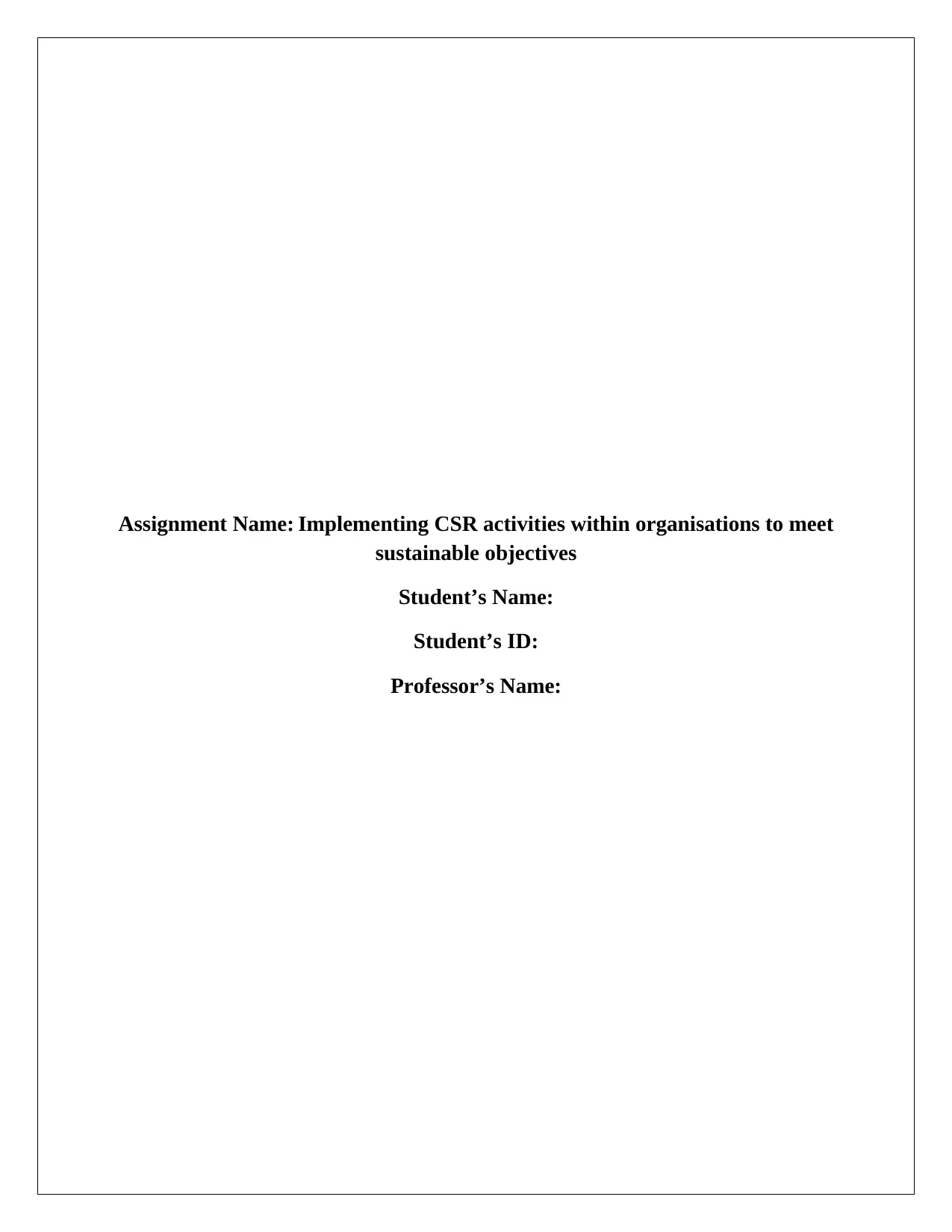
Assignment Name: Implementing CSR activities within organisations to meet
sustainable objectives
Student’s Name:
Student’s ID:
Professor’s Name:
sustainable objectives
Student’s Name:
Student’s ID:
Professor’s Name:
Secure Best Marks with AI Grader
Need help grading? Try our AI Grader for instant feedback on your assignments.
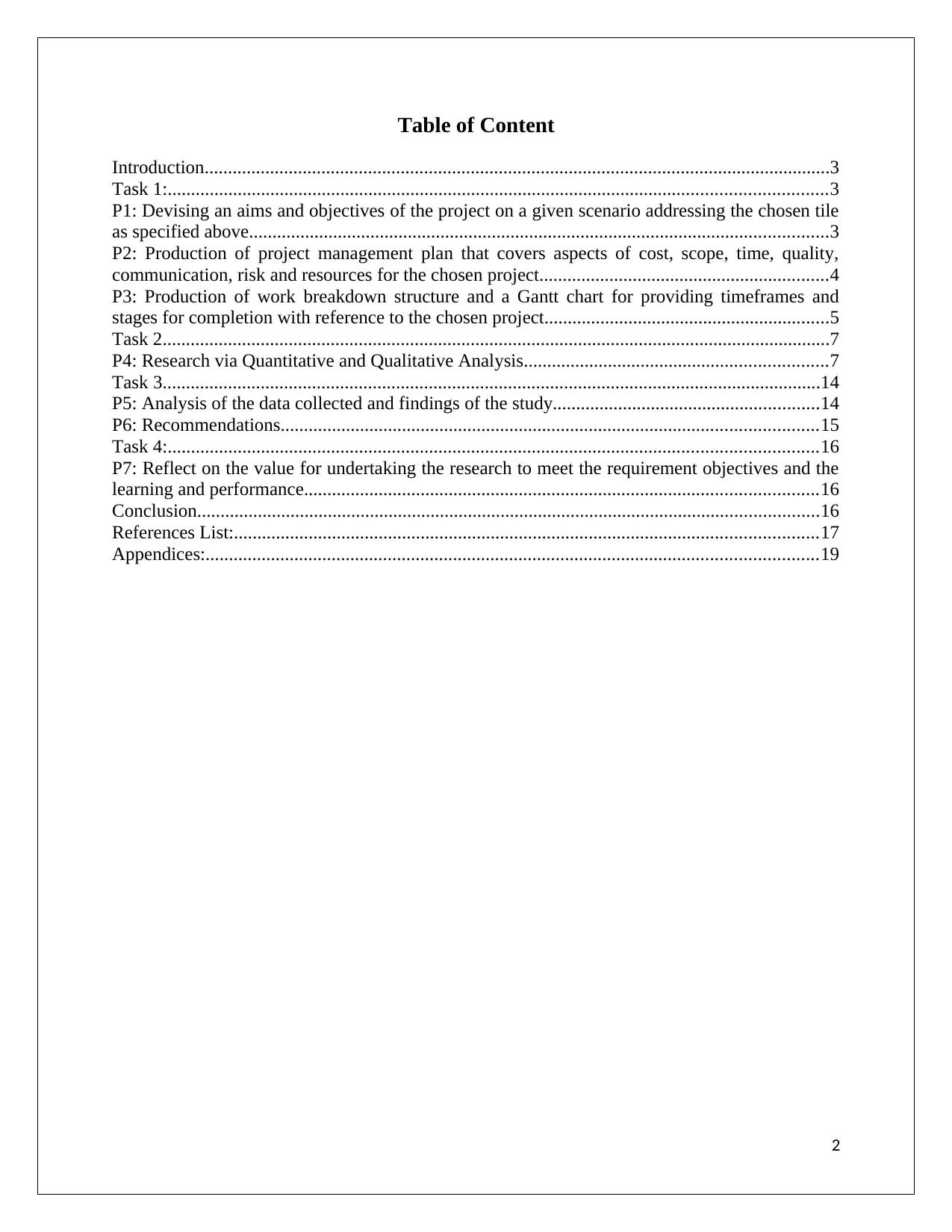
Table of Content
Introduction......................................................................................................................................3
Task 1:.............................................................................................................................................3
P1: Devising an aims and objectives of the project on a given scenario addressing the chosen tile
as specified above............................................................................................................................3
P2: Production of project management plan that covers aspects of cost, scope, time, quality,
communication, risk and resources for the chosen project..............................................................4
P3: Production of work breakdown structure and a Gantt chart for providing timeframes and
stages for completion with reference to the chosen project.............................................................5
Task 2...............................................................................................................................................7
P4: Research via Quantitative and Qualitative Analysis.................................................................7
Task 3.............................................................................................................................................14
P5: Analysis of the data collected and findings of the study.........................................................14
P6: Recommendations...................................................................................................................15
Task 4:...........................................................................................................................................16
P7: Reflect on the value for undertaking the research to meet the requirement objectives and the
learning and performance..............................................................................................................16
Conclusion.....................................................................................................................................16
References List:.............................................................................................................................17
Appendices:...................................................................................................................................19
2
Introduction......................................................................................................................................3
Task 1:.............................................................................................................................................3
P1: Devising an aims and objectives of the project on a given scenario addressing the chosen tile
as specified above............................................................................................................................3
P2: Production of project management plan that covers aspects of cost, scope, time, quality,
communication, risk and resources for the chosen project..............................................................4
P3: Production of work breakdown structure and a Gantt chart for providing timeframes and
stages for completion with reference to the chosen project.............................................................5
Task 2...............................................................................................................................................7
P4: Research via Quantitative and Qualitative Analysis.................................................................7
Task 3.............................................................................................................................................14
P5: Analysis of the data collected and findings of the study.........................................................14
P6: Recommendations...................................................................................................................15
Task 4:...........................................................................................................................................16
P7: Reflect on the value for undertaking the research to meet the requirement objectives and the
learning and performance..............................................................................................................16
Conclusion.....................................................................................................................................16
References List:.............................................................................................................................17
Appendices:...................................................................................................................................19
2
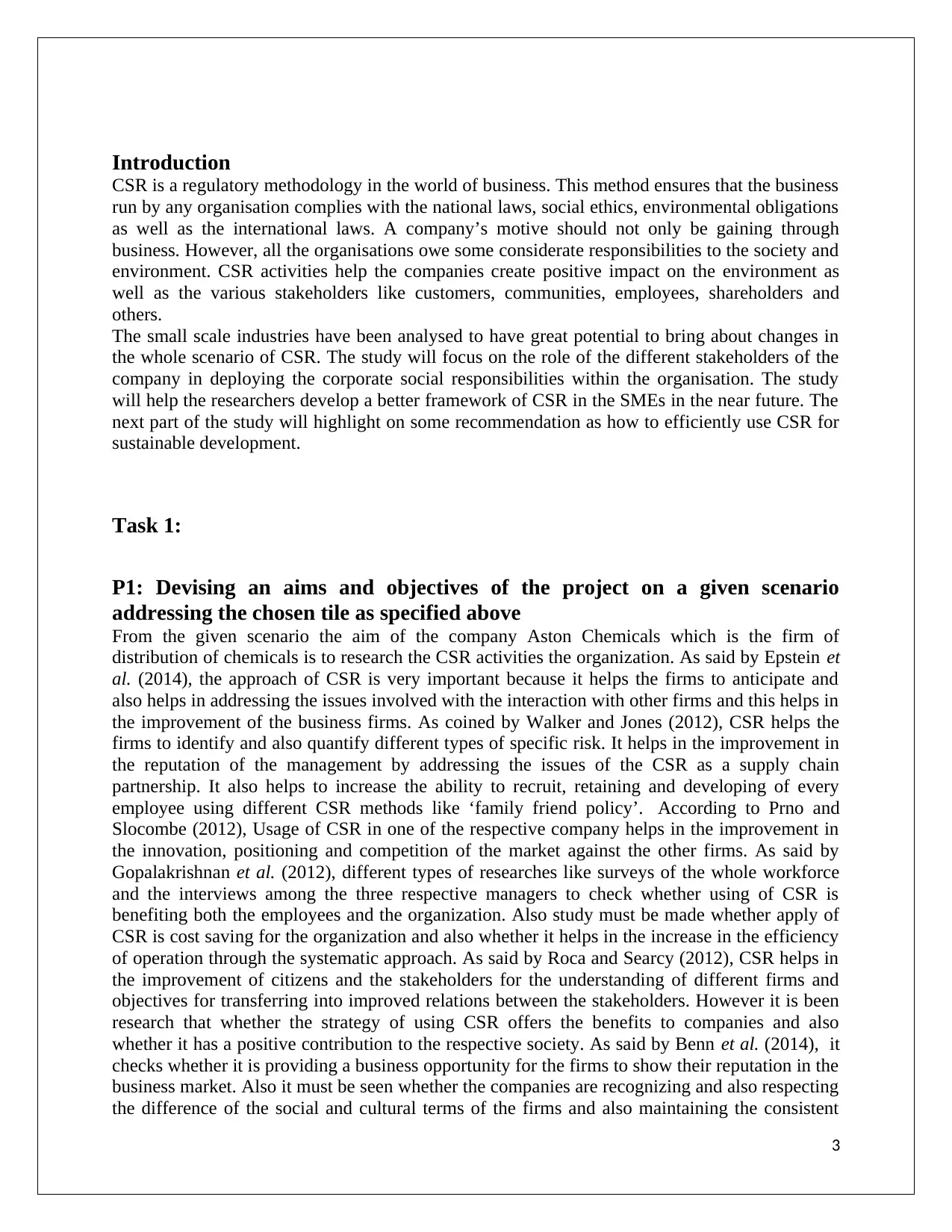
Introduction
CSR is a regulatory methodology in the world of business. This method ensures that the business
run by any organisation complies with the national laws, social ethics, environmental obligations
as well as the international laws. A company’s motive should not only be gaining through
business. However, all the organisations owe some considerate responsibilities to the society and
environment. CSR activities help the companies create positive impact on the environment as
well as the various stakeholders like customers, communities, employees, shareholders and
others.
The small scale industries have been analysed to have great potential to bring about changes in
the whole scenario of CSR. The study will focus on the role of the different stakeholders of the
company in deploying the corporate social responsibilities within the organisation. The study
will help the researchers develop a better framework of CSR in the SMEs in the near future. The
next part of the study will highlight on some recommendation as how to efficiently use CSR for
sustainable development.
Task 1:
P1: Devising an aims and objectives of the project on a given scenario
addressing the chosen tile as specified above
From the given scenario the aim of the company Aston Chemicals which is the firm of
distribution of chemicals is to research the CSR activities the organization. As said by Epstein et
al. (2014), the approach of CSR is very important because it helps the firms to anticipate and
also helps in addressing the issues involved with the interaction with other firms and this helps in
the improvement of the business firms. As coined by Walker and Jones (2012), CSR helps the
firms to identify and also quantify different types of specific risk. It helps in the improvement in
the reputation of the management by addressing the issues of the CSR as a supply chain
partnership. It also helps to increase the ability to recruit, retaining and developing of every
employee using different CSR methods like ‘family friend policy’. According to Prno and
Slocombe (2012), Usage of CSR in one of the respective company helps in the improvement in
the innovation, positioning and competition of the market against the other firms. As said by
Gopalakrishnan et al. (2012), different types of researches like surveys of the whole workforce
and the interviews among the three respective managers to check whether using of CSR is
benefiting both the employees and the organization. Also study must be made whether apply of
CSR is cost saving for the organization and also whether it helps in the increase in the efficiency
of operation through the systematic approach. As said by Roca and Searcy (2012), CSR helps in
the improvement of citizens and the stakeholders for the understanding of different firms and
objectives for transferring into improved relations between the stakeholders. However it is been
research that whether the strategy of using CSR offers the benefits to companies and also
whether it has a positive contribution to the respective society. As said by Benn et al. (2014), it
checks whether it is providing a business opportunity for the firms to show their reputation in the
business market. Also it must be seen whether the companies are recognizing and also respecting
the difference of the social and cultural terms of the firms and also maintaining the consistent
3
CSR is a regulatory methodology in the world of business. This method ensures that the business
run by any organisation complies with the national laws, social ethics, environmental obligations
as well as the international laws. A company’s motive should not only be gaining through
business. However, all the organisations owe some considerate responsibilities to the society and
environment. CSR activities help the companies create positive impact on the environment as
well as the various stakeholders like customers, communities, employees, shareholders and
others.
The small scale industries have been analysed to have great potential to bring about changes in
the whole scenario of CSR. The study will focus on the role of the different stakeholders of the
company in deploying the corporate social responsibilities within the organisation. The study
will help the researchers develop a better framework of CSR in the SMEs in the near future. The
next part of the study will highlight on some recommendation as how to efficiently use CSR for
sustainable development.
Task 1:
P1: Devising an aims and objectives of the project on a given scenario
addressing the chosen tile as specified above
From the given scenario the aim of the company Aston Chemicals which is the firm of
distribution of chemicals is to research the CSR activities the organization. As said by Epstein et
al. (2014), the approach of CSR is very important because it helps the firms to anticipate and
also helps in addressing the issues involved with the interaction with other firms and this helps in
the improvement of the business firms. As coined by Walker and Jones (2012), CSR helps the
firms to identify and also quantify different types of specific risk. It helps in the improvement in
the reputation of the management by addressing the issues of the CSR as a supply chain
partnership. It also helps to increase the ability to recruit, retaining and developing of every
employee using different CSR methods like ‘family friend policy’. According to Prno and
Slocombe (2012), Usage of CSR in one of the respective company helps in the improvement in
the innovation, positioning and competition of the market against the other firms. As said by
Gopalakrishnan et al. (2012), different types of researches like surveys of the whole workforce
and the interviews among the three respective managers to check whether using of CSR is
benefiting both the employees and the organization. Also study must be made whether apply of
CSR is cost saving for the organization and also whether it helps in the increase in the efficiency
of operation through the systematic approach. As said by Roca and Searcy (2012), CSR helps in
the improvement of citizens and the stakeholders for the understanding of different firms and
objectives for transferring into improved relations between the stakeholders. However it is been
research that whether the strategy of using CSR offers the benefits to companies and also
whether it has a positive contribution to the respective society. As said by Benn et al. (2014), it
checks whether it is providing a business opportunity for the firms to show their reputation in the
business market. Also it must be seen whether the companies are recognizing and also respecting
the difference of the social and cultural terms of the firms and also maintaining the consistent
3
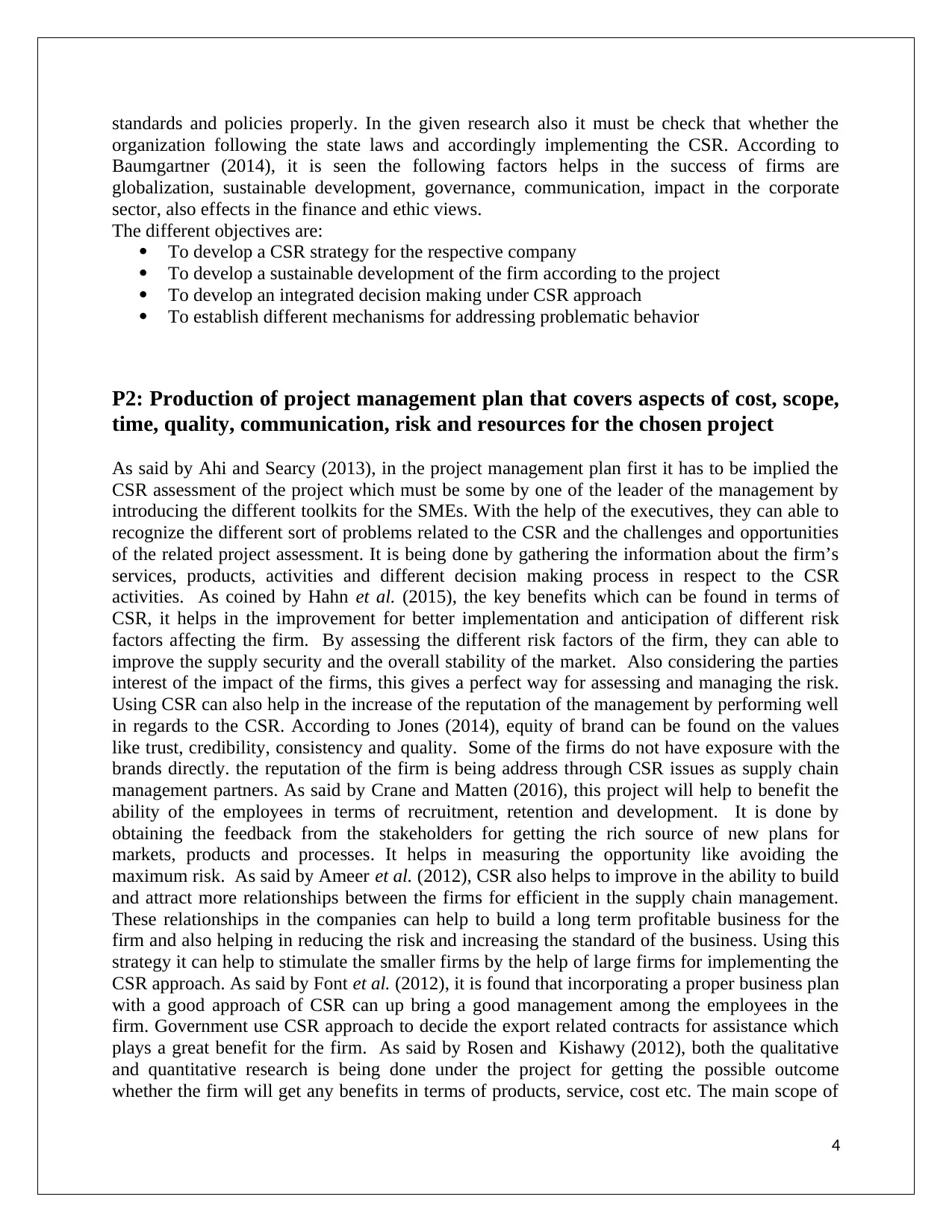
standards and policies properly. In the given research also it must be check that whether the
organization following the state laws and accordingly implementing the CSR. According to
Baumgartner (2014), it is seen the following factors helps in the success of firms are
globalization, sustainable development, governance, communication, impact in the corporate
sector, also effects in the finance and ethic views.
The different objectives are:
To develop a CSR strategy for the respective company
To develop a sustainable development of the firm according to the project
To develop an integrated decision making under CSR approach
To establish different mechanisms for addressing problematic behavior
P2: Production of project management plan that covers aspects of cost, scope,
time, quality, communication, risk and resources for the chosen project
As said by Ahi and Searcy (2013), in the project management plan first it has to be implied the
CSR assessment of the project which must be some by one of the leader of the management by
introducing the different toolkits for the SMEs. With the help of the executives, they can able to
recognize the different sort of problems related to the CSR and the challenges and opportunities
of the related project assessment. It is being done by gathering the information about the firm’s
services, products, activities and different decision making process in respect to the CSR
activities. As coined by Hahn et al. (2015), the key benefits which can be found in terms of
CSR, it helps in the improvement for better implementation and anticipation of different risk
factors affecting the firm. By assessing the different risk factors of the firm, they can able to
improve the supply security and the overall stability of the market. Also considering the parties
interest of the impact of the firms, this gives a perfect way for assessing and managing the risk.
Using CSR can also help in the increase of the reputation of the management by performing well
in regards to the CSR. According to Jones (2014), equity of brand can be found on the values
like trust, credibility, consistency and quality. Some of the firms do not have exposure with the
brands directly. the reputation of the firm is being address through CSR issues as supply chain
management partners. As said by Crane and Matten (2016), this project will help to benefit the
ability of the employees in terms of recruitment, retention and development. It is done by
obtaining the feedback from the stakeholders for getting the rich source of new plans for
markets, products and processes. It helps in measuring the opportunity like avoiding the
maximum risk. As said by Ameer et al. (2012), CSR also helps to improve in the ability to build
and attract more relationships between the firms for efficient in the supply chain management.
These relationships in the companies can help to build a long term profitable business for the
firm and also helping in reducing the risk and increasing the standard of the business. Using this
strategy it can help to stimulate the smaller firms by the help of large firms for implementing the
CSR approach. As said by Font et al. (2012), it is found that incorporating a proper business plan
with a good approach of CSR can up bring a good management among the employees in the
firm. Government use CSR approach to decide the export related contracts for assistance which
plays a great benefit for the firm. As said by Rosen and Kishawy (2012), both the qualitative
and quantitative research is being done under the project for getting the possible outcome
whether the firm will get any benefits in terms of products, service, cost etc. The main scope of
4
organization following the state laws and accordingly implementing the CSR. According to
Baumgartner (2014), it is seen the following factors helps in the success of firms are
globalization, sustainable development, governance, communication, impact in the corporate
sector, also effects in the finance and ethic views.
The different objectives are:
To develop a CSR strategy for the respective company
To develop a sustainable development of the firm according to the project
To develop an integrated decision making under CSR approach
To establish different mechanisms for addressing problematic behavior
P2: Production of project management plan that covers aspects of cost, scope,
time, quality, communication, risk and resources for the chosen project
As said by Ahi and Searcy (2013), in the project management plan first it has to be implied the
CSR assessment of the project which must be some by one of the leader of the management by
introducing the different toolkits for the SMEs. With the help of the executives, they can able to
recognize the different sort of problems related to the CSR and the challenges and opportunities
of the related project assessment. It is being done by gathering the information about the firm’s
services, products, activities and different decision making process in respect to the CSR
activities. As coined by Hahn et al. (2015), the key benefits which can be found in terms of
CSR, it helps in the improvement for better implementation and anticipation of different risk
factors affecting the firm. By assessing the different risk factors of the firm, they can able to
improve the supply security and the overall stability of the market. Also considering the parties
interest of the impact of the firms, this gives a perfect way for assessing and managing the risk.
Using CSR can also help in the increase of the reputation of the management by performing well
in regards to the CSR. According to Jones (2014), equity of brand can be found on the values
like trust, credibility, consistency and quality. Some of the firms do not have exposure with the
brands directly. the reputation of the firm is being address through CSR issues as supply chain
management partners. As said by Crane and Matten (2016), this project will help to benefit the
ability of the employees in terms of recruitment, retention and development. It is done by
obtaining the feedback from the stakeholders for getting the rich source of new plans for
markets, products and processes. It helps in measuring the opportunity like avoiding the
maximum risk. As said by Ameer et al. (2012), CSR also helps to improve in the ability to build
and attract more relationships between the firms for efficient in the supply chain management.
These relationships in the companies can help to build a long term profitable business for the
firm and also helping in reducing the risk and increasing the standard of the business. Using this
strategy it can help to stimulate the smaller firms by the help of large firms for implementing the
CSR approach. As said by Font et al. (2012), it is found that incorporating a proper business plan
with a good approach of CSR can up bring a good management among the employees in the
firm. Government use CSR approach to decide the export related contracts for assistance which
plays a great benefit for the firm. As said by Rosen and Kishawy (2012), both the qualitative
and quantitative research is being done under the project for getting the possible outcome
whether the firm will get any benefits in terms of products, service, cost etc. The main scope of
4
Paraphrase This Document
Need a fresh take? Get an instant paraphrase of this document with our AI Paraphraser
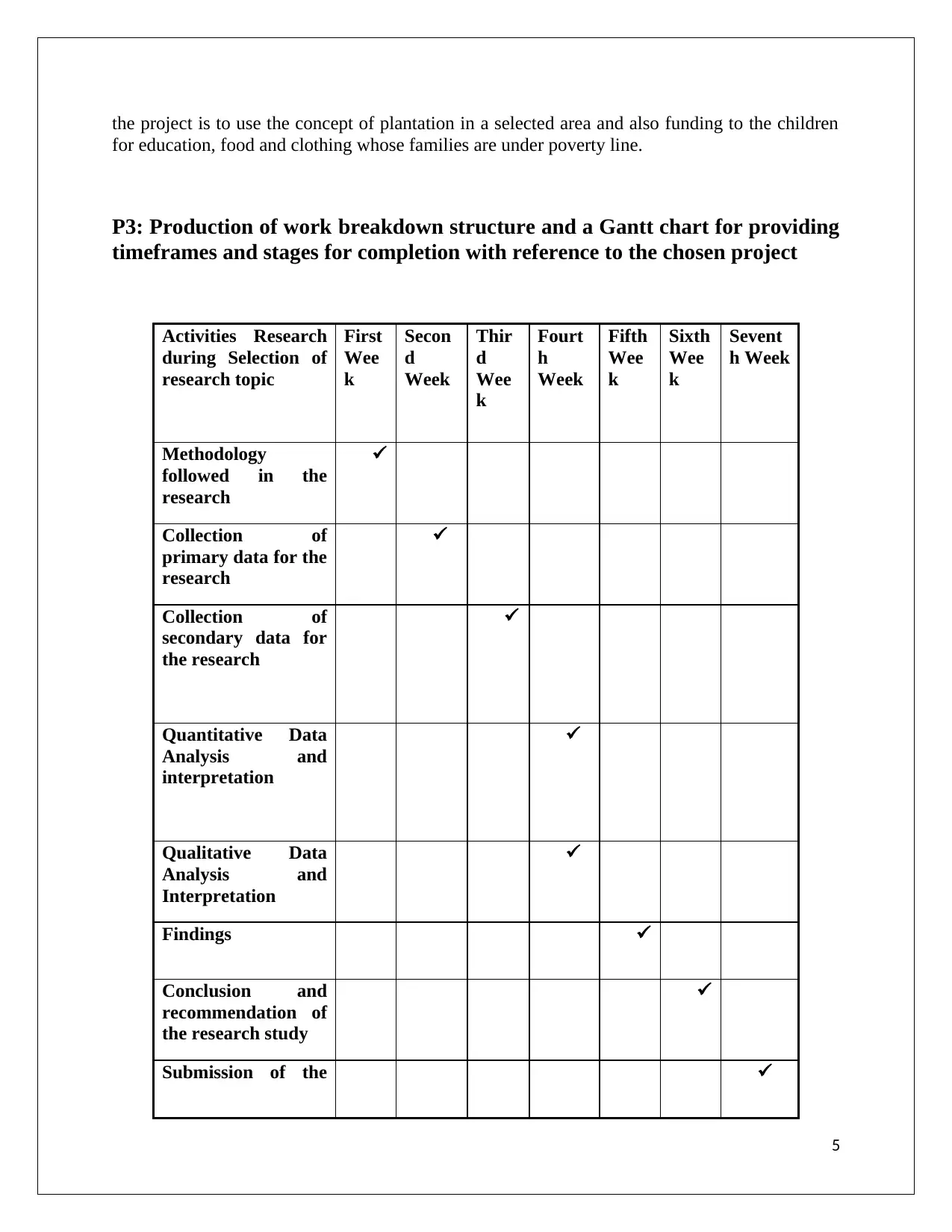
the project is to use the concept of plantation in a selected area and also funding to the children
for education, food and clothing whose families are under poverty line.
P3: Production of work breakdown structure and a Gantt chart for providing
timeframes and stages for completion with reference to the chosen project
Activities Research
during Selection of
research topic
First
Wee
k
Secon
d
Week
Thir
d
Wee
k
Fourt
h
Week
Fifth
Wee
k
Sixth
Wee
k
Sevent
h Week
Methodology
followed in the
research
Collection of
primary data for the
research
Collection of
secondary data for
the research
Quantitative Data
Analysis and
interpretation
Qualitative Data
Analysis and
Interpretation
Findings
Conclusion and
recommendation of
the research study
Submission of the
5
for education, food and clothing whose families are under poverty line.
P3: Production of work breakdown structure and a Gantt chart for providing
timeframes and stages for completion with reference to the chosen project
Activities Research
during Selection of
research topic
First
Wee
k
Secon
d
Week
Thir
d
Wee
k
Fourt
h
Week
Fifth
Wee
k
Sixth
Wee
k
Sevent
h Week
Methodology
followed in the
research
Collection of
primary data for the
research
Collection of
secondary data for
the research
Quantitative Data
Analysis and
interpretation
Qualitative Data
Analysis and
Interpretation
Findings
Conclusion and
recommendation of
the research study
Submission of the
5
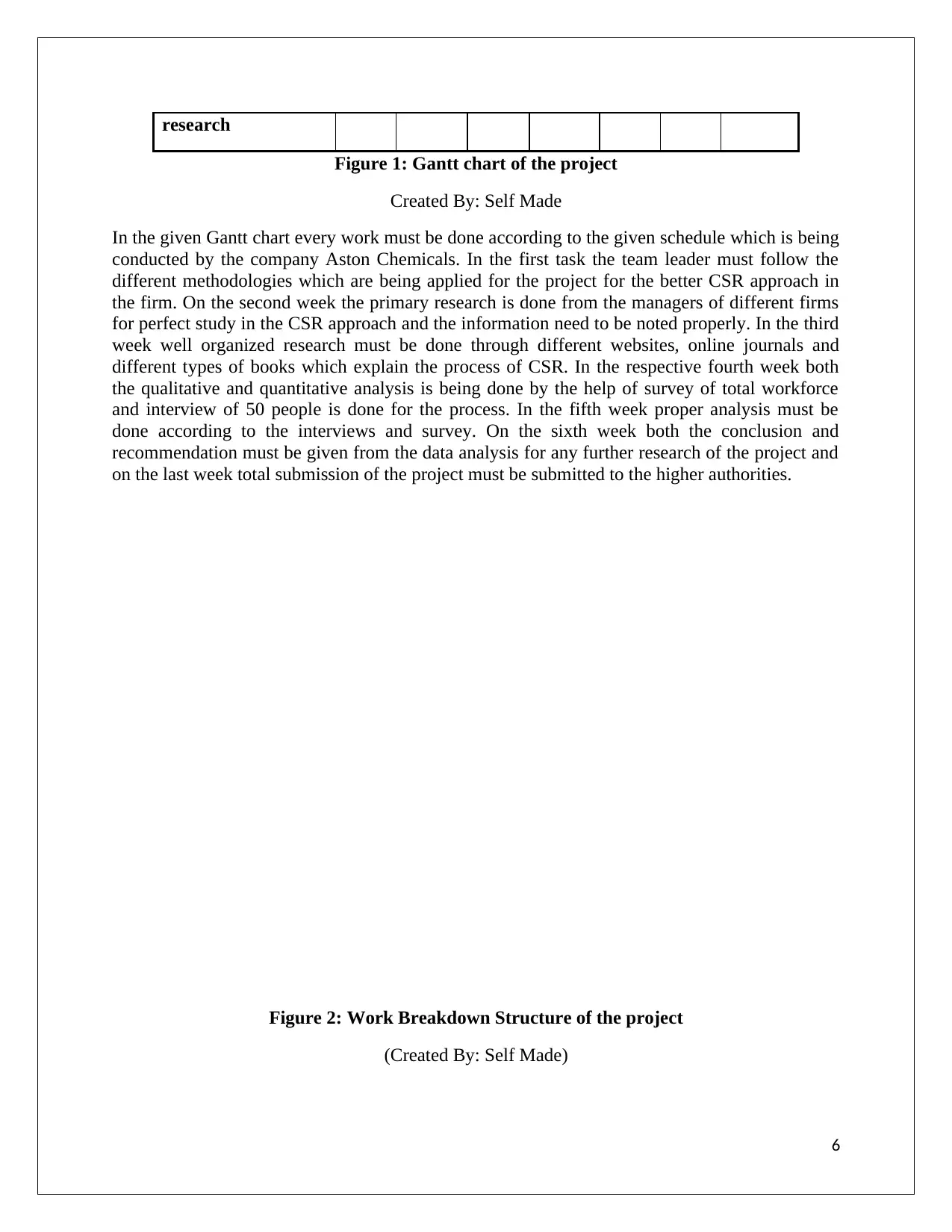
research
Figure 1: Gantt chart of the project
Created By: Self Made
In the given Gantt chart every work must be done according to the given schedule which is being
conducted by the company Aston Chemicals. In the first task the team leader must follow the
different methodologies which are being applied for the project for the better CSR approach in
the firm. On the second week the primary research is done from the managers of different firms
for perfect study in the CSR approach and the information need to be noted properly. In the third
week well organized research must be done through different websites, online journals and
different types of books which explain the process of CSR. In the respective fourth week both
the qualitative and quantitative analysis is being done by the help of survey of total workforce
and interview of 50 people is done for the process. In the fifth week proper analysis must be
done according to the interviews and survey. On the sixth week both the conclusion and
recommendation must be given from the data analysis for any further research of the project and
on the last week total submission of the project must be submitted to the higher authorities.
Figure 2: Work Breakdown Structure of the project
(Created By: Self Made)
6
Figure 1: Gantt chart of the project
Created By: Self Made
In the given Gantt chart every work must be done according to the given schedule which is being
conducted by the company Aston Chemicals. In the first task the team leader must follow the
different methodologies which are being applied for the project for the better CSR approach in
the firm. On the second week the primary research is done from the managers of different firms
for perfect study in the CSR approach and the information need to be noted properly. In the third
week well organized research must be done through different websites, online journals and
different types of books which explain the process of CSR. In the respective fourth week both
the qualitative and quantitative analysis is being done by the help of survey of total workforce
and interview of 50 people is done for the process. In the fifth week proper analysis must be
done according to the interviews and survey. On the sixth week both the conclusion and
recommendation must be given from the data analysis for any further research of the project and
on the last week total submission of the project must be submitted to the higher authorities.
Figure 2: Work Breakdown Structure of the project
(Created By: Self Made)
6
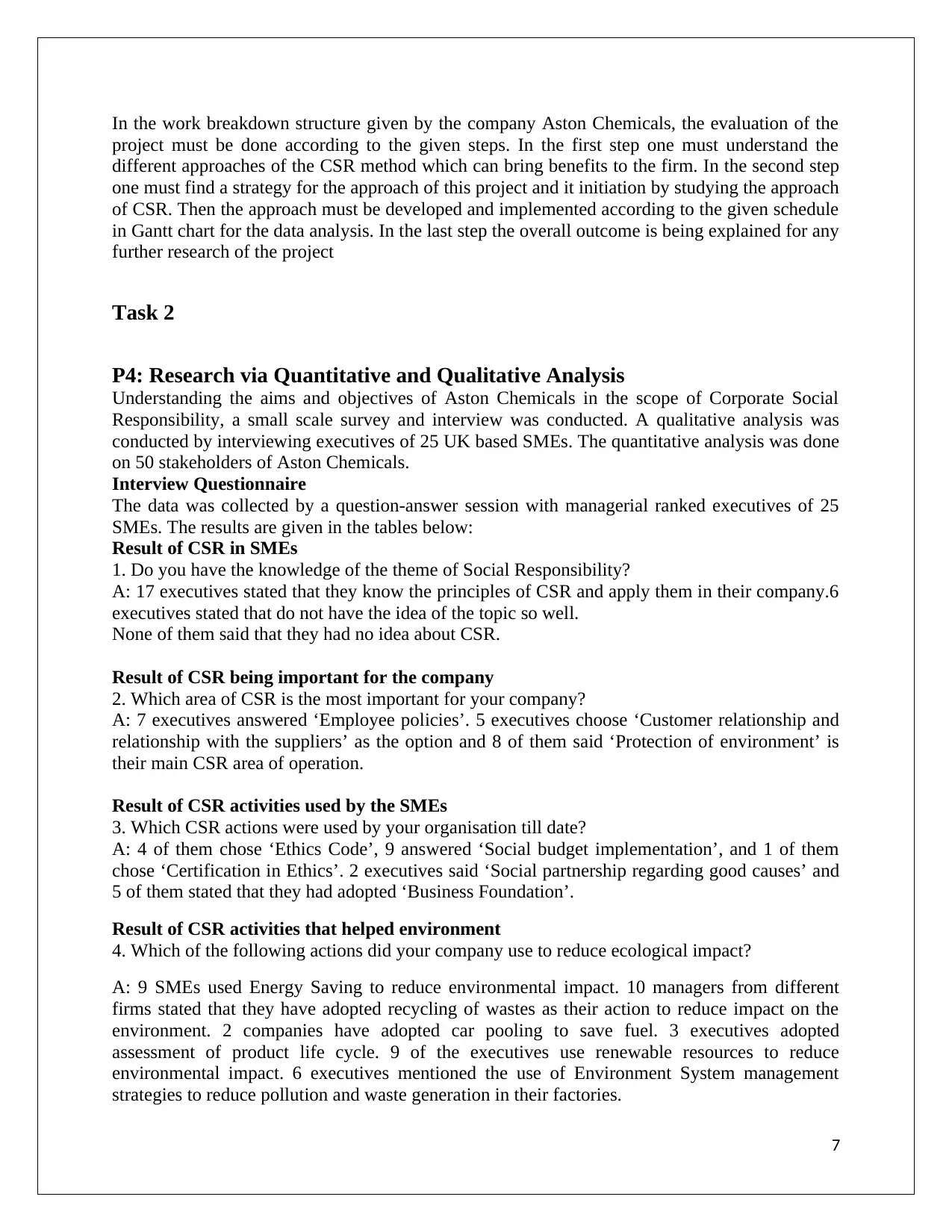
In the work breakdown structure given by the company Aston Chemicals, the evaluation of the
project must be done according to the given steps. In the first step one must understand the
different approaches of the CSR method which can bring benefits to the firm. In the second step
one must find a strategy for the approach of this project and it initiation by studying the approach
of CSR. Then the approach must be developed and implemented according to the given schedule
in Gantt chart for the data analysis. In the last step the overall outcome is being explained for any
further research of the project
Task 2
P4: Research via Quantitative and Qualitative Analysis
Understanding the aims and objectives of Aston Chemicals in the scope of Corporate Social
Responsibility, a small scale survey and interview was conducted. A qualitative analysis was
conducted by interviewing executives of 25 UK based SMEs. The quantitative analysis was done
on 50 stakeholders of Aston Chemicals.
Interview Questionnaire
The data was collected by a question-answer session with managerial ranked executives of 25
SMEs. The results are given in the tables below:
Result of CSR in SMEs
1. Do you have the knowledge of the theme of Social Responsibility?
A: 17 executives stated that they know the principles of CSR and apply them in their company.6
executives stated that do not have the idea of the topic so well.
None of them said that they had no idea about CSR.
Result of CSR being important for the company
2. Which area of CSR is the most important for your company?
A: 7 executives answered ‘Employee policies’. 5 executives choose ‘Customer relationship and
relationship with the suppliers’ as the option and 8 of them said ‘Protection of environment’ is
their main CSR area of operation.
Result of CSR activities used by the SMEs
3. Which CSR actions were used by your organisation till date?
A: 4 of them chose ‘Ethics Code’, 9 answered ‘Social budget implementation’, and 1 of them
chose ‘Certification in Ethics’. 2 executives said ‘Social partnership regarding good causes’ and
5 of them stated that they had adopted ‘Business Foundation’.
Result of CSR activities that helped environment
4. Which of the following actions did your company use to reduce ecological impact?
A: 9 SMEs used Energy Saving to reduce environmental impact. 10 managers from different
firms stated that they have adopted recycling of wastes as their action to reduce impact on the
environment. 2 companies have adopted car pooling to save fuel. 3 executives adopted
assessment of product life cycle. 9 of the executives use renewable resources to reduce
environmental impact. 6 executives mentioned the use of Environment System management
strategies to reduce pollution and waste generation in their factories.
7
project must be done according to the given steps. In the first step one must understand the
different approaches of the CSR method which can bring benefits to the firm. In the second step
one must find a strategy for the approach of this project and it initiation by studying the approach
of CSR. Then the approach must be developed and implemented according to the given schedule
in Gantt chart for the data analysis. In the last step the overall outcome is being explained for any
further research of the project
Task 2
P4: Research via Quantitative and Qualitative Analysis
Understanding the aims and objectives of Aston Chemicals in the scope of Corporate Social
Responsibility, a small scale survey and interview was conducted. A qualitative analysis was
conducted by interviewing executives of 25 UK based SMEs. The quantitative analysis was done
on 50 stakeholders of Aston Chemicals.
Interview Questionnaire
The data was collected by a question-answer session with managerial ranked executives of 25
SMEs. The results are given in the tables below:
Result of CSR in SMEs
1. Do you have the knowledge of the theme of Social Responsibility?
A: 17 executives stated that they know the principles of CSR and apply them in their company.6
executives stated that do not have the idea of the topic so well.
None of them said that they had no idea about CSR.
Result of CSR being important for the company
2. Which area of CSR is the most important for your company?
A: 7 executives answered ‘Employee policies’. 5 executives choose ‘Customer relationship and
relationship with the suppliers’ as the option and 8 of them said ‘Protection of environment’ is
their main CSR area of operation.
Result of CSR activities used by the SMEs
3. Which CSR actions were used by your organisation till date?
A: 4 of them chose ‘Ethics Code’, 9 answered ‘Social budget implementation’, and 1 of them
chose ‘Certification in Ethics’. 2 executives said ‘Social partnership regarding good causes’ and
5 of them stated that they had adopted ‘Business Foundation’.
Result of CSR activities that helped environment
4. Which of the following actions did your company use to reduce ecological impact?
A: 9 SMEs used Energy Saving to reduce environmental impact. 10 managers from different
firms stated that they have adopted recycling of wastes as their action to reduce impact on the
environment. 2 companies have adopted car pooling to save fuel. 3 executives adopted
assessment of product life cycle. 9 of the executives use renewable resources to reduce
environmental impact. 6 executives mentioned the use of Environment System management
strategies to reduce pollution and waste generation in their factories.
7
Secure Best Marks with AI Grader
Need help grading? Try our AI Grader for instant feedback on your assignments.

Results of Benefits of deploying CSR
3. What has been the main benefit of your company after using CSR activities?
A: The following options were chosen out of all the six options given to the executives of SMEs.
2 executives stated ‘Betterment of reputation’. 7 managers stated ‘Better relationships with the
various stakeholders and community’ 12 executives stated ‘To make the employee sense better’.
3 stated ‘enhance the efficiency’. 2 of them stated ‘Identifying the areas of risk to company’s
reputation’. 2 executives stated ‘Better credit accesses.
Results of CSR policies that the SMEs have planned for future
3. What are the CSR plans of your company in the years to come?
A: The following methodologies were adopted as future CSR policies by the executives of
SMEs. 8 employees stated ‘Communication of performance of the company in CSR and
sustenance of stakeholders’. 7 executives stated ‘Improving existing products to create less
impact on environment’. 3 of them stated ‘Developing eco-friendly alternatives and new
products to reduce ecological problems’. 2 managers stated ‘Reducing the energy consumption
in the processes of the company’. 4 executives stated ‘Reduction of greenhouse emission and
waste generation’. 2 of them stated ‘Incorporating control in the supply based on human rights’.
Survey Questionnaire
A survey was conducted on 50 people from a target community to gather data for the quantitative
analysis. The results of the survey are mentioned below:
Q 1: Is there a need to develop a green patch around the locality of the company?
Responses Response Percentage Frequency of responds Total Respondent
Yes 81.1% 40 50
No 18.9% 10 50
Maybe 0 0 50
8
3. What has been the main benefit of your company after using CSR activities?
A: The following options were chosen out of all the six options given to the executives of SMEs.
2 executives stated ‘Betterment of reputation’. 7 managers stated ‘Better relationships with the
various stakeholders and community’ 12 executives stated ‘To make the employee sense better’.
3 stated ‘enhance the efficiency’. 2 of them stated ‘Identifying the areas of risk to company’s
reputation’. 2 executives stated ‘Better credit accesses.
Results of CSR policies that the SMEs have planned for future
3. What are the CSR plans of your company in the years to come?
A: The following methodologies were adopted as future CSR policies by the executives of
SMEs. 8 employees stated ‘Communication of performance of the company in CSR and
sustenance of stakeholders’. 7 executives stated ‘Improving existing products to create less
impact on environment’. 3 of them stated ‘Developing eco-friendly alternatives and new
products to reduce ecological problems’. 2 managers stated ‘Reducing the energy consumption
in the processes of the company’. 4 executives stated ‘Reduction of greenhouse emission and
waste generation’. 2 of them stated ‘Incorporating control in the supply based on human rights’.
Survey Questionnaire
A survey was conducted on 50 people from a target community to gather data for the quantitative
analysis. The results of the survey are mentioned below:
Q 1: Is there a need to develop a green patch around the locality of the company?
Responses Response Percentage Frequency of responds Total Respondent
Yes 81.1% 40 50
No 18.9% 10 50
Maybe 0 0 50
8
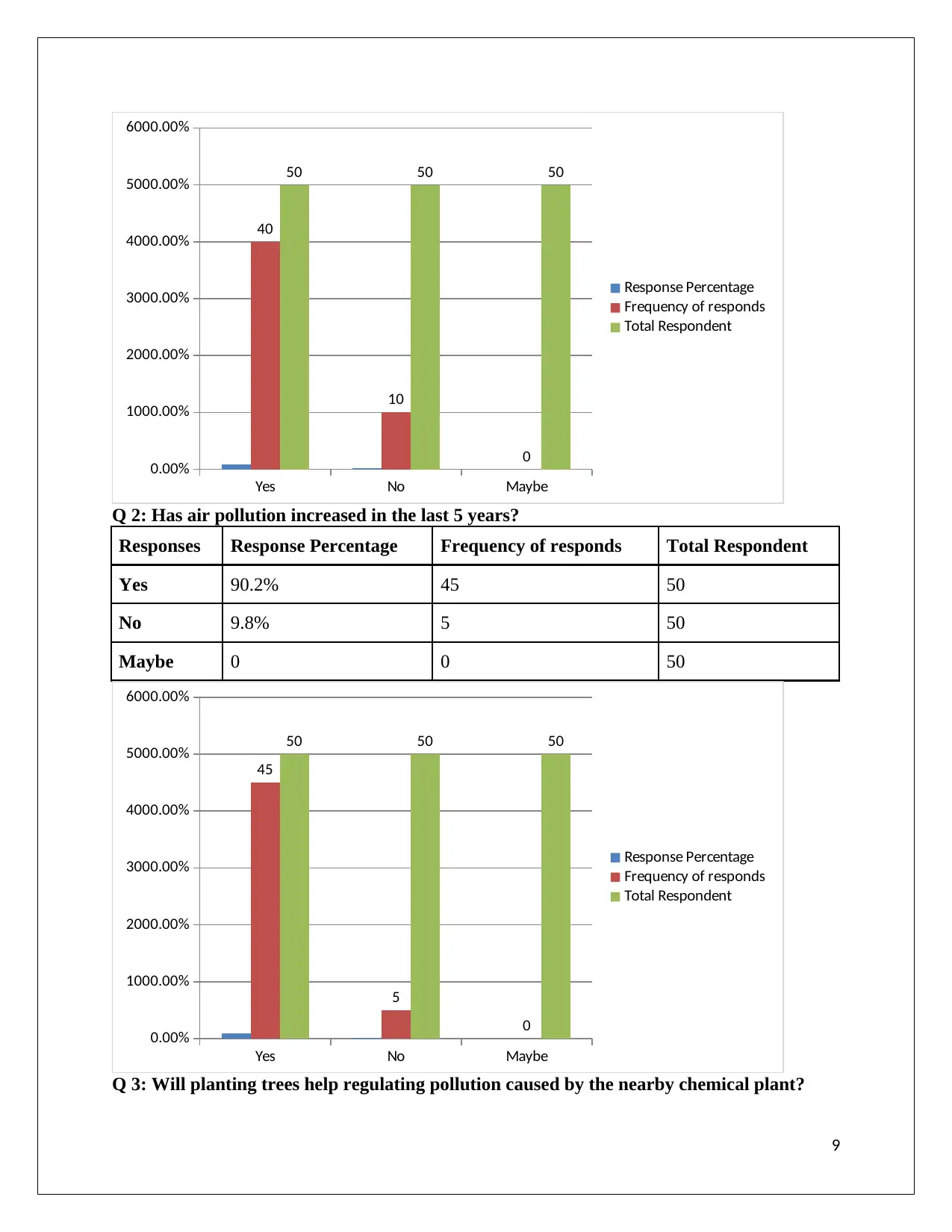
Yes No Maybe
0.00%
1000.00%
2000.00%
3000.00%
4000.00%
5000.00%
6000.00%
40
10
0
50 50 50
Response Percentage
Frequency of responds
Total Respondent
Q 2: Has air pollution increased in the last 5 years?
Responses Response Percentage Frequency of responds Total Respondent
Yes 90.2% 45 50
No 9.8% 5 50
Maybe 0 0 50
Yes No Maybe
0.00%
1000.00%
2000.00%
3000.00%
4000.00%
5000.00%
6000.00%
45
5
0
50 50 50
Response Percentage
Frequency of responds
Total Respondent
Q 3: Will planting trees help regulating pollution caused by the nearby chemical plant?
9
0.00%
1000.00%
2000.00%
3000.00%
4000.00%
5000.00%
6000.00%
40
10
0
50 50 50
Response Percentage
Frequency of responds
Total Respondent
Q 2: Has air pollution increased in the last 5 years?
Responses Response Percentage Frequency of responds Total Respondent
Yes 90.2% 45 50
No 9.8% 5 50
Maybe 0 0 50
Yes No Maybe
0.00%
1000.00%
2000.00%
3000.00%
4000.00%
5000.00%
6000.00%
45
5
0
50 50 50
Response Percentage
Frequency of responds
Total Respondent
Q 3: Will planting trees help regulating pollution caused by the nearby chemical plant?
9
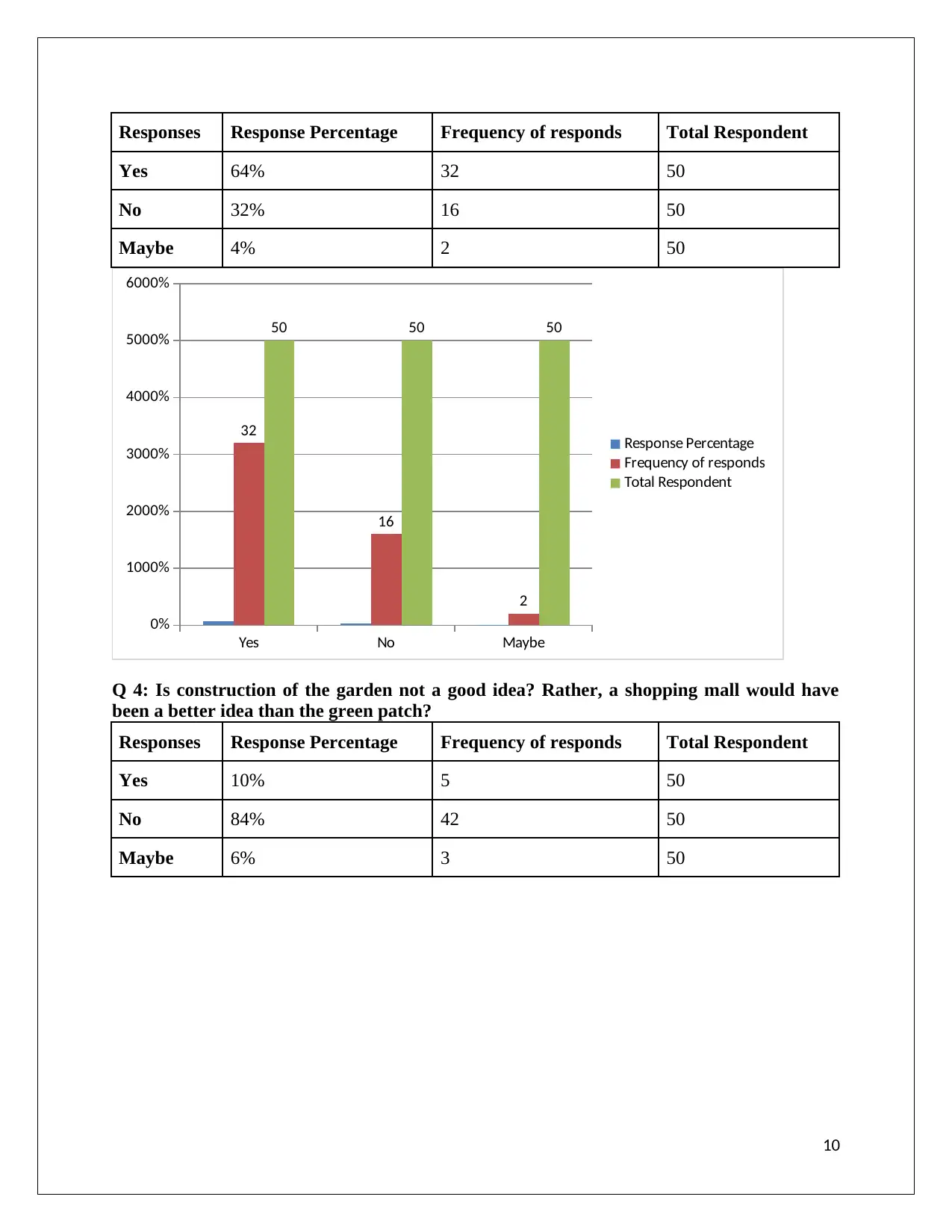
Responses Response Percentage Frequency of responds Total Respondent
Yes 64% 32 50
No 32% 16 50
Maybe 4% 2 50
Yes No Maybe
0%
1000%
2000%
3000%
4000%
5000%
6000%
32
16
2
50 50 50
Response Percentage
Frequency of responds
Total Respondent
Q 4: Is construction of the garden not a good idea? Rather, a shopping mall would have
been a better idea than the green patch?
Responses Response Percentage Frequency of responds Total Respondent
Yes 10% 5 50
No 84% 42 50
Maybe 6% 3 50
10
Yes 64% 32 50
No 32% 16 50
Maybe 4% 2 50
Yes No Maybe
0%
1000%
2000%
3000%
4000%
5000%
6000%
32
16
2
50 50 50
Response Percentage
Frequency of responds
Total Respondent
Q 4: Is construction of the garden not a good idea? Rather, a shopping mall would have
been a better idea than the green patch?
Responses Response Percentage Frequency of responds Total Respondent
Yes 10% 5 50
No 84% 42 50
Maybe 6% 3 50
10
Paraphrase This Document
Need a fresh take? Get an instant paraphrase of this document with our AI Paraphraser
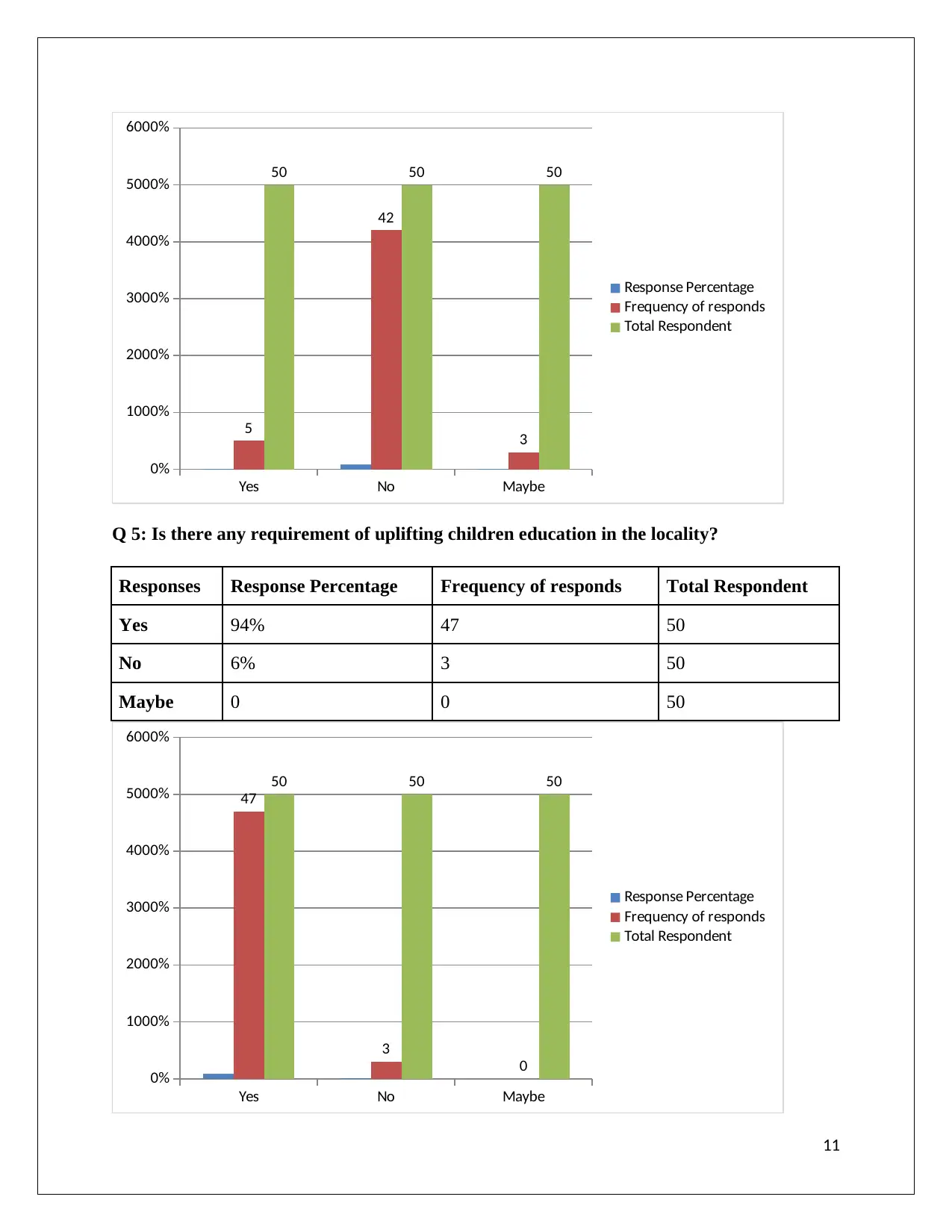
Yes No Maybe
0%
1000%
2000%
3000%
4000%
5000%
6000%
5
42
3
50 50 50
Response Percentage
Frequency of responds
Total Respondent
Q 5: Is there any requirement of uplifting children education in the locality?
Responses Response Percentage Frequency of responds Total Respondent
Yes 94% 47 50
No 6% 3 50
Maybe 0 0 50
Yes No Maybe
0%
1000%
2000%
3000%
4000%
5000%
6000%
47
3
0
50 50 50
Response Percentage
Frequency of responds
Total Respondent
11
0%
1000%
2000%
3000%
4000%
5000%
6000%
5
42
3
50 50 50
Response Percentage
Frequency of responds
Total Respondent
Q 5: Is there any requirement of uplifting children education in the locality?
Responses Response Percentage Frequency of responds Total Respondent
Yes 94% 47 50
No 6% 3 50
Maybe 0 0 50
Yes No Maybe
0%
1000%
2000%
3000%
4000%
5000%
6000%
47
3
0
50 50 50
Response Percentage
Frequency of responds
Total Respondent
11

Q 6: Is there any need to start a home for underprivileged children and orphans in the
neighbourhood?
Responses Response Percentage Frequency of responds Total Respondent
Yes 70% 35 50
No 30% 15 50
Maybe 0 0 50
Yes No Maybe
0%
1000%
2000%
3000%
4000%
5000%
6000%
35
15
0
50 50 50
Response Percentage
Frequency of responds
Total Respondent
Q 7: Is there funding crisis in the existing orphanages which is leading them to provide
inefficient child care services?
Responses Response Percentage Frequency of responds Total Respondent
Yes 74% 37 50
No 26% 13 50
Maybe 0 0 50
12
neighbourhood?
Responses Response Percentage Frequency of responds Total Respondent
Yes 70% 35 50
No 30% 15 50
Maybe 0 0 50
Yes No Maybe
0%
1000%
2000%
3000%
4000%
5000%
6000%
35
15
0
50 50 50
Response Percentage
Frequency of responds
Total Respondent
Q 7: Is there funding crisis in the existing orphanages which is leading them to provide
inefficient child care services?
Responses Response Percentage Frequency of responds Total Respondent
Yes 74% 37 50
No 26% 13 50
Maybe 0 0 50
12
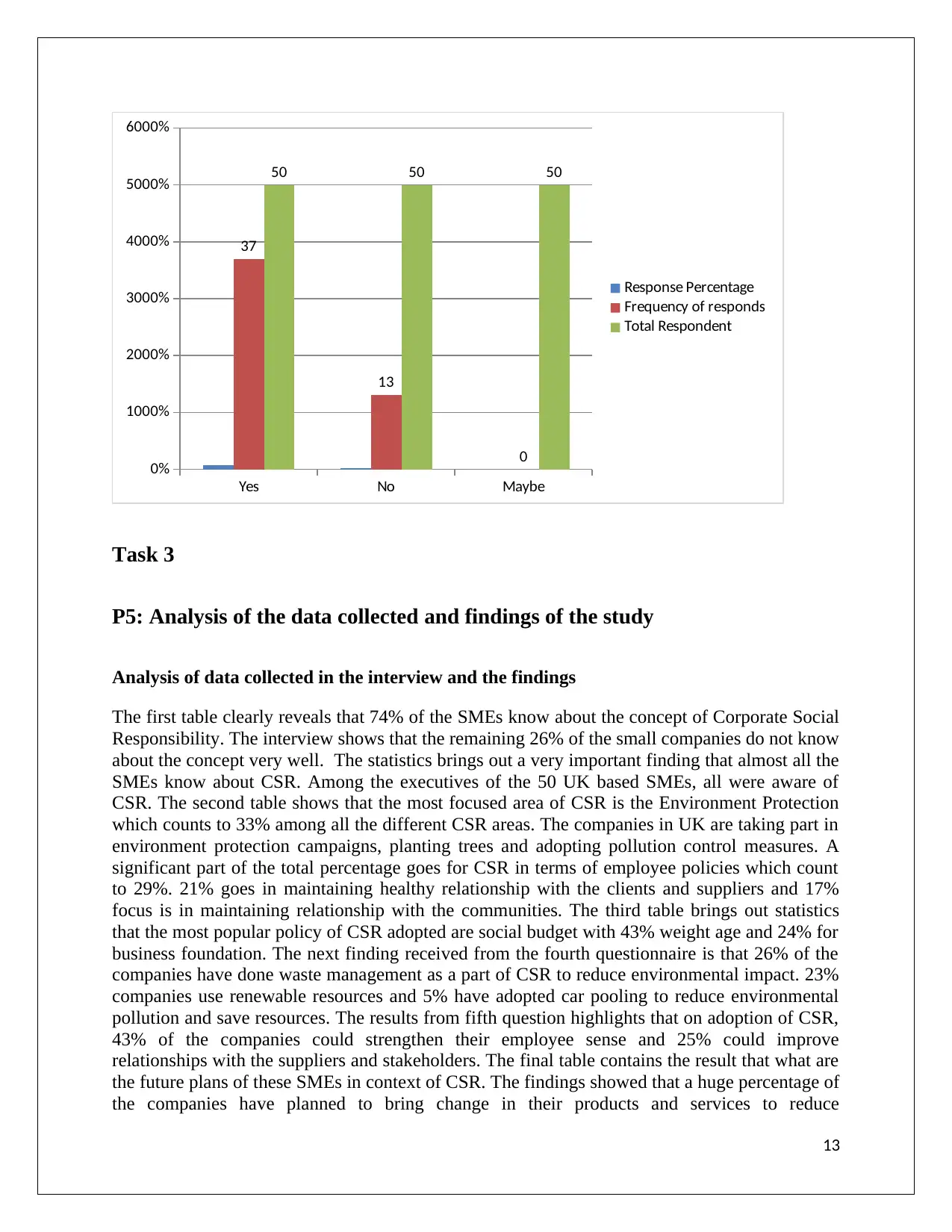
Yes No Maybe
0%
1000%
2000%
3000%
4000%
5000%
6000%
37
13
0
50 50 50
Response Percentage
Frequency of responds
Total Respondent
Task 3
P5: Analysis of the data collected and findings of the study
Analysis of data collected in the interview and the findings
The first table clearly reveals that 74% of the SMEs know about the concept of Corporate Social
Responsibility. The interview shows that the remaining 26% of the small companies do not know
about the concept very well. The statistics brings out a very important finding that almost all the
SMEs know about CSR. Among the executives of the 50 UK based SMEs, all were aware of
CSR. The second table shows that the most focused area of CSR is the Environment Protection
which counts to 33% among all the different CSR areas. The companies in UK are taking part in
environment protection campaigns, planting trees and adopting pollution control measures. A
significant part of the total percentage goes for CSR in terms of employee policies which count
to 29%. 21% goes in maintaining healthy relationship with the clients and suppliers and 17%
focus is in maintaining relationship with the communities. The third table brings out statistics
that the most popular policy of CSR adopted are social budget with 43% weight age and 24% for
business foundation. The next finding received from the fourth questionnaire is that 26% of the
companies have done waste management as a part of CSR to reduce environmental impact. 23%
companies use renewable resources and 5% have adopted car pooling to reduce environmental
pollution and save resources. The results from fifth question highlights that on adoption of CSR,
43% of the companies could strengthen their employee sense and 25% could improve
relationships with the suppliers and stakeholders. The final table contains the result that what are
the future plans of these SMEs in context of CSR. The findings showed that a huge percentage of
the companies have planned to bring change in their products and services to reduce
13
0%
1000%
2000%
3000%
4000%
5000%
6000%
37
13
0
50 50 50
Response Percentage
Frequency of responds
Total Respondent
Task 3
P5: Analysis of the data collected and findings of the study
Analysis of data collected in the interview and the findings
The first table clearly reveals that 74% of the SMEs know about the concept of Corporate Social
Responsibility. The interview shows that the remaining 26% of the small companies do not know
about the concept very well. The statistics brings out a very important finding that almost all the
SMEs know about CSR. Among the executives of the 50 UK based SMEs, all were aware of
CSR. The second table shows that the most focused area of CSR is the Environment Protection
which counts to 33% among all the different CSR areas. The companies in UK are taking part in
environment protection campaigns, planting trees and adopting pollution control measures. A
significant part of the total percentage goes for CSR in terms of employee policies which count
to 29%. 21% goes in maintaining healthy relationship with the clients and suppliers and 17%
focus is in maintaining relationship with the communities. The third table brings out statistics
that the most popular policy of CSR adopted are social budget with 43% weight age and 24% for
business foundation. The next finding received from the fourth questionnaire is that 26% of the
companies have done waste management as a part of CSR to reduce environmental impact. 23%
companies use renewable resources and 5% have adopted car pooling to reduce environmental
pollution and save resources. The results from fifth question highlights that on adoption of CSR,
43% of the companies could strengthen their employee sense and 25% could improve
relationships with the suppliers and stakeholders. The final table contains the result that what are
the future plans of these SMEs in context of CSR. The findings showed that a huge percentage of
the companies have planned to bring change in their products and services to reduce
13
Secure Best Marks with AI Grader
Need help grading? Try our AI Grader for instant feedback on your assignments.
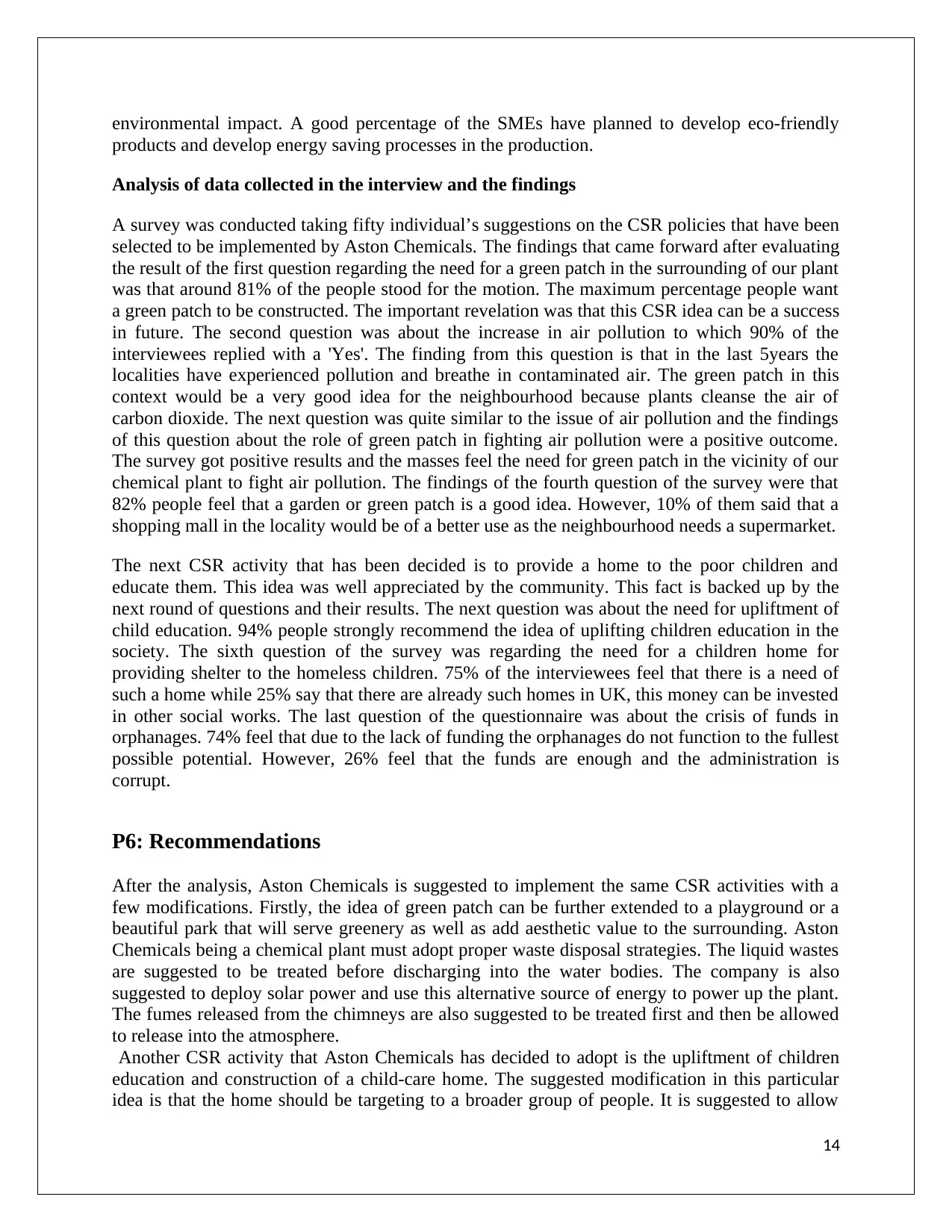
environmental impact. A good percentage of the SMEs have planned to develop eco-friendly
products and develop energy saving processes in the production.
Analysis of data collected in the interview and the findings
A survey was conducted taking fifty individual’s suggestions on the CSR policies that have been
selected to be implemented by Aston Chemicals. The findings that came forward after evaluating
the result of the first question regarding the need for a green patch in the surrounding of our plant
was that around 81% of the people stood for the motion. The maximum percentage people want
a green patch to be constructed. The important revelation was that this CSR idea can be a success
in future. The second question was about the increase in air pollution to which 90% of the
interviewees replied with a 'Yes'. The finding from this question is that in the last 5years the
localities have experienced pollution and breathe in contaminated air. The green patch in this
context would be a very good idea for the neighbourhood because plants cleanse the air of
carbon dioxide. The next question was quite similar to the issue of air pollution and the findings
of this question about the role of green patch in fighting air pollution were a positive outcome.
The survey got positive results and the masses feel the need for green patch in the vicinity of our
chemical plant to fight air pollution. The findings of the fourth question of the survey were that
82% people feel that a garden or green patch is a good idea. However, 10% of them said that a
shopping mall in the locality would be of a better use as the neighbourhood needs a supermarket.
The next CSR activity that has been decided is to provide a home to the poor children and
educate them. This idea was well appreciated by the community. This fact is backed up by the
next round of questions and their results. The next question was about the need for upliftment of
child education. 94% people strongly recommend the idea of uplifting children education in the
society. The sixth question of the survey was regarding the need for a children home for
providing shelter to the homeless children. 75% of the interviewees feel that there is a need of
such a home while 25% say that there are already such homes in UK, this money can be invested
in other social works. The last question of the questionnaire was about the crisis of funds in
orphanages. 74% feel that due to the lack of funding the orphanages do not function to the fullest
possible potential. However, 26% feel that the funds are enough and the administration is
corrupt.
P6: Recommendations
After the analysis, Aston Chemicals is suggested to implement the same CSR activities with a
few modifications. Firstly, the idea of green patch can be further extended to a playground or a
beautiful park that will serve greenery as well as add aesthetic value to the surrounding. Aston
Chemicals being a chemical plant must adopt proper waste disposal strategies. The liquid wastes
are suggested to be treated before discharging into the water bodies. The company is also
suggested to deploy solar power and use this alternative source of energy to power up the plant.
The fumes released from the chimneys are also suggested to be treated first and then be allowed
to release into the atmosphere.
Another CSR activity that Aston Chemicals has decided to adopt is the upliftment of children
education and construction of a child-care home. The suggested modification in this particular
idea is that the home should be targeting to a broader group of people. It is suggested to allow
14
products and develop energy saving processes in the production.
Analysis of data collected in the interview and the findings
A survey was conducted taking fifty individual’s suggestions on the CSR policies that have been
selected to be implemented by Aston Chemicals. The findings that came forward after evaluating
the result of the first question regarding the need for a green patch in the surrounding of our plant
was that around 81% of the people stood for the motion. The maximum percentage people want
a green patch to be constructed. The important revelation was that this CSR idea can be a success
in future. The second question was about the increase in air pollution to which 90% of the
interviewees replied with a 'Yes'. The finding from this question is that in the last 5years the
localities have experienced pollution and breathe in contaminated air. The green patch in this
context would be a very good idea for the neighbourhood because plants cleanse the air of
carbon dioxide. The next question was quite similar to the issue of air pollution and the findings
of this question about the role of green patch in fighting air pollution were a positive outcome.
The survey got positive results and the masses feel the need for green patch in the vicinity of our
chemical plant to fight air pollution. The findings of the fourth question of the survey were that
82% people feel that a garden or green patch is a good idea. However, 10% of them said that a
shopping mall in the locality would be of a better use as the neighbourhood needs a supermarket.
The next CSR activity that has been decided is to provide a home to the poor children and
educate them. This idea was well appreciated by the community. This fact is backed up by the
next round of questions and their results. The next question was about the need for upliftment of
child education. 94% people strongly recommend the idea of uplifting children education in the
society. The sixth question of the survey was regarding the need for a children home for
providing shelter to the homeless children. 75% of the interviewees feel that there is a need of
such a home while 25% say that there are already such homes in UK, this money can be invested
in other social works. The last question of the questionnaire was about the crisis of funds in
orphanages. 74% feel that due to the lack of funding the orphanages do not function to the fullest
possible potential. However, 26% feel that the funds are enough and the administration is
corrupt.
P6: Recommendations
After the analysis, Aston Chemicals is suggested to implement the same CSR activities with a
few modifications. Firstly, the idea of green patch can be further extended to a playground or a
beautiful park that will serve greenery as well as add aesthetic value to the surrounding. Aston
Chemicals being a chemical plant must adopt proper waste disposal strategies. The liquid wastes
are suggested to be treated before discharging into the water bodies. The company is also
suggested to deploy solar power and use this alternative source of energy to power up the plant.
The fumes released from the chimneys are also suggested to be treated first and then be allowed
to release into the atmosphere.
Another CSR activity that Aston Chemicals has decided to adopt is the upliftment of children
education and construction of a child-care home. The suggested modification in this particular
idea is that the home should be targeting to a broader group of people. It is suggested to allow
14

old-aged needy people too, because the older folks need care similar to the children. It is also
recommended that Aston Chemical start the social venture by partnering with other interested
organisations and under the guidance of social workers who can better serve as pioneers in these
kinds of activities.
Task 4:
P7: Reflect on the value for undertaking the research to meet the requirement
objectives and the learning and performance.
From the survey the result which has been found that majority of the people wants to get
involved in the activities of the project. Many of the employees did not know the knowledge of
the approach of the CSR. That’s why these projects had interest for many people. Many people
want the overall environment to be cleaned and less polluted. Everyone is very much aware
about the protection of their own nature and environment. The main thing is that the approach of
CSR will play a very important role in the future for all the people as it will create more and
more awareness to the people about the environment and their respective societies like the people
who are under poverty line. Main problem that arise is that the need of the supermarkets is
increasing for the people which is a bad sign as many kids not going outside due to shortage of
playing grounds so they are more involved in the indoor activities. It also seen a great result
when they are responded to the kids whose family can’t afford to sent them to schools. Also
there was positive feedback from every firm that some percentage of money will be given for the
benefits of the homeless kids so that they can able to shelter and have proper hygienic food to
stay healthy. According to the interviews many has a positive feedback for the approach of the
CSR. IT will surely increase the reputation of the respective country very much.
Conclusion
The study highlighted remarkable statistics about corporate social Responsibility. The Company
still has huge scope of development as far as CSR is concerned. The interview of Executives and
Managers of a few local SMEs gave out good results as far as their awareness about CSR is
concerned. The growth of these small scale industries have been highly dependent on the CSR
activities because these sensible acts had helped the company gain popularity in the society
leading to hike in their customer-base. The primary revelation of the study highlighted that better
relation with all the stakeholders is the main factor under the subject of CSR deployment in a
SME. The study also discussed the various CSR policies Aston Chemicals has been using along
with the future CSR regarding policies and planning that the company wishes to adopt as a future
objective. This study also gave statistics about the awareness of general masses about the subject
of Corporate Social Responsibility.
15
recommended that Aston Chemical start the social venture by partnering with other interested
organisations and under the guidance of social workers who can better serve as pioneers in these
kinds of activities.
Task 4:
P7: Reflect on the value for undertaking the research to meet the requirement
objectives and the learning and performance.
From the survey the result which has been found that majority of the people wants to get
involved in the activities of the project. Many of the employees did not know the knowledge of
the approach of the CSR. That’s why these projects had interest for many people. Many people
want the overall environment to be cleaned and less polluted. Everyone is very much aware
about the protection of their own nature and environment. The main thing is that the approach of
CSR will play a very important role in the future for all the people as it will create more and
more awareness to the people about the environment and their respective societies like the people
who are under poverty line. Main problem that arise is that the need of the supermarkets is
increasing for the people which is a bad sign as many kids not going outside due to shortage of
playing grounds so they are more involved in the indoor activities. It also seen a great result
when they are responded to the kids whose family can’t afford to sent them to schools. Also
there was positive feedback from every firm that some percentage of money will be given for the
benefits of the homeless kids so that they can able to shelter and have proper hygienic food to
stay healthy. According to the interviews many has a positive feedback for the approach of the
CSR. IT will surely increase the reputation of the respective country very much.
Conclusion
The study highlighted remarkable statistics about corporate social Responsibility. The Company
still has huge scope of development as far as CSR is concerned. The interview of Executives and
Managers of a few local SMEs gave out good results as far as their awareness about CSR is
concerned. The growth of these small scale industries have been highly dependent on the CSR
activities because these sensible acts had helped the company gain popularity in the society
leading to hike in their customer-base. The primary revelation of the study highlighted that better
relation with all the stakeholders is the main factor under the subject of CSR deployment in a
SME. The study also discussed the various CSR policies Aston Chemicals has been using along
with the future CSR regarding policies and planning that the company wishes to adopt as a future
objective. This study also gave statistics about the awareness of general masses about the subject
of Corporate Social Responsibility.
15
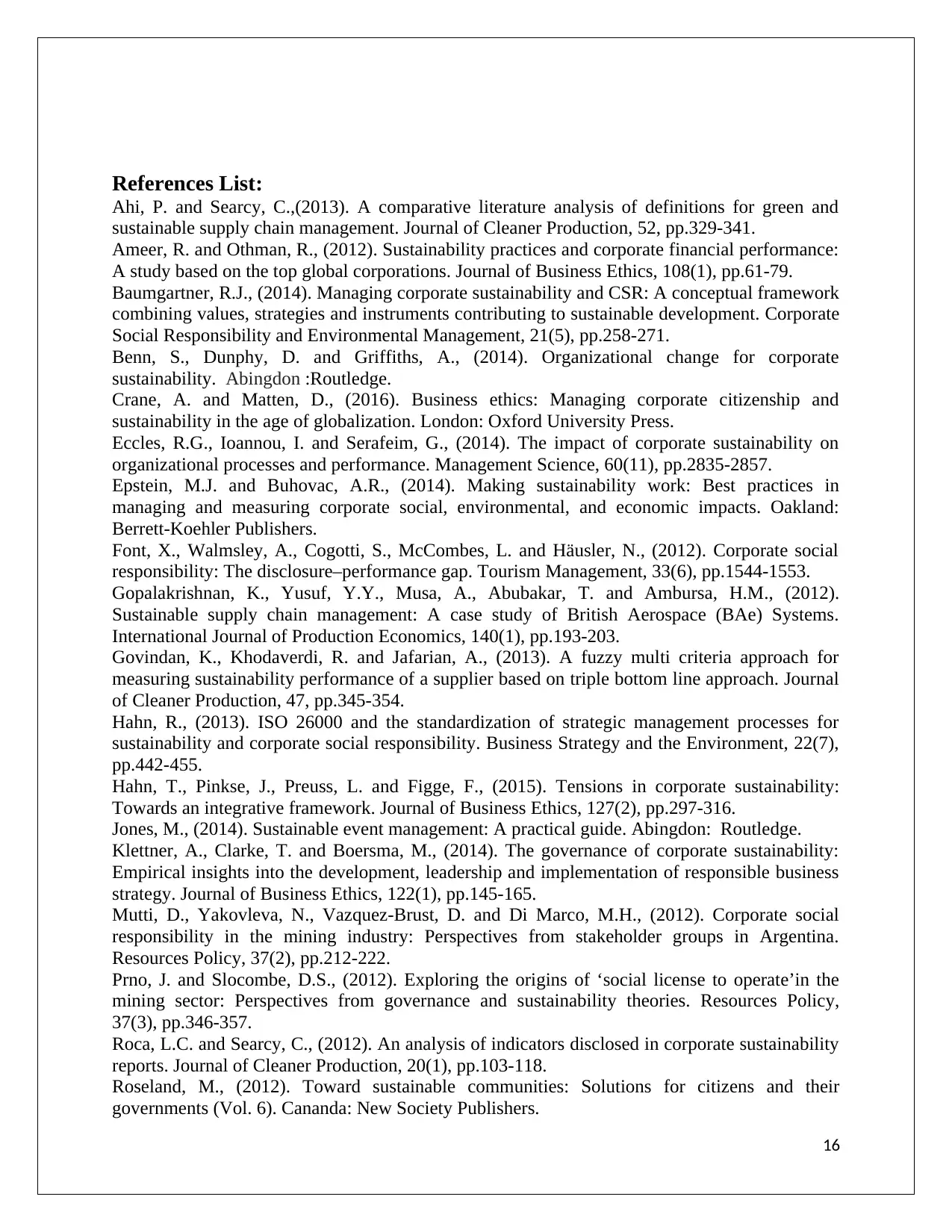
References List:
Ahi, P. and Searcy, C.,(2013). A comparative literature analysis of definitions for green and
sustainable supply chain management. Journal of Cleaner Production, 52, pp.329-341.
Ameer, R. and Othman, R., (2012). Sustainability practices and corporate financial performance:
A study based on the top global corporations. Journal of Business Ethics, 108(1), pp.61-79.
Baumgartner, R.J., (2014). Managing corporate sustainability and CSR: A conceptual framework
combining values, strategies and instruments contributing to sustainable development. Corporate
Social Responsibility and Environmental Management, 21(5), pp.258-271.
Benn, S., Dunphy, D. and Griffiths, A., (2014). Organizational change for corporate
sustainability. Abingdon :Routledge.
Crane, A. and Matten, D., (2016). Business ethics: Managing corporate citizenship and
sustainability in the age of globalization. London: Oxford University Press.
Eccles, R.G., Ioannou, I. and Serafeim, G., (2014). The impact of corporate sustainability on
organizational processes and performance. Management Science, 60(11), pp.2835-2857.
Epstein, M.J. and Buhovac, A.R., (2014). Making sustainability work: Best practices in
managing and measuring corporate social, environmental, and economic impacts. Oakland:
Berrett-Koehler Publishers.
Font, X., Walmsley, A., Cogotti, S., McCombes, L. and Häusler, N., (2012). Corporate social
responsibility: The disclosure–performance gap. Tourism Management, 33(6), pp.1544-1553.
Gopalakrishnan, K., Yusuf, Y.Y., Musa, A., Abubakar, T. and Ambursa, H.M., (2012).
Sustainable supply chain management: A case study of British Aerospace (BAe) Systems.
International Journal of Production Economics, 140(1), pp.193-203.
Govindan, K., Khodaverdi, R. and Jafarian, A., (2013). A fuzzy multi criteria approach for
measuring sustainability performance of a supplier based on triple bottom line approach. Journal
of Cleaner Production, 47, pp.345-354.
Hahn, R., (2013). ISO 26000 and the standardization of strategic management processes for
sustainability and corporate social responsibility. Business Strategy and the Environment, 22(7),
pp.442-455.
Hahn, T., Pinkse, J., Preuss, L. and Figge, F., (2015). Tensions in corporate sustainability:
Towards an integrative framework. Journal of Business Ethics, 127(2), pp.297-316.
Jones, M., (2014). Sustainable event management: A practical guide. Abingdon: Routledge.
Klettner, A., Clarke, T. and Boersma, M., (2014). The governance of corporate sustainability:
Empirical insights into the development, leadership and implementation of responsible business
strategy. Journal of Business Ethics, 122(1), pp.145-165.
Mutti, D., Yakovleva, N., Vazquez-Brust, D. and Di Marco, M.H., (2012). Corporate social
responsibility in the mining industry: Perspectives from stakeholder groups in Argentina.
Resources Policy, 37(2), pp.212-222.
Prno, J. and Slocombe, D.S., (2012). Exploring the origins of ‘social license to operate’in the
mining sector: Perspectives from governance and sustainability theories. Resources Policy,
37(3), pp.346-357.
Roca, L.C. and Searcy, C., (2012). An analysis of indicators disclosed in corporate sustainability
reports. Journal of Cleaner Production, 20(1), pp.103-118.
Roseland, M., (2012). Toward sustainable communities: Solutions for citizens and their
governments (Vol. 6). Cananda: New Society Publishers.
16
Ahi, P. and Searcy, C.,(2013). A comparative literature analysis of definitions for green and
sustainable supply chain management. Journal of Cleaner Production, 52, pp.329-341.
Ameer, R. and Othman, R., (2012). Sustainability practices and corporate financial performance:
A study based on the top global corporations. Journal of Business Ethics, 108(1), pp.61-79.
Baumgartner, R.J., (2014). Managing corporate sustainability and CSR: A conceptual framework
combining values, strategies and instruments contributing to sustainable development. Corporate
Social Responsibility and Environmental Management, 21(5), pp.258-271.
Benn, S., Dunphy, D. and Griffiths, A., (2014). Organizational change for corporate
sustainability. Abingdon :Routledge.
Crane, A. and Matten, D., (2016). Business ethics: Managing corporate citizenship and
sustainability in the age of globalization. London: Oxford University Press.
Eccles, R.G., Ioannou, I. and Serafeim, G., (2014). The impact of corporate sustainability on
organizational processes and performance. Management Science, 60(11), pp.2835-2857.
Epstein, M.J. and Buhovac, A.R., (2014). Making sustainability work: Best practices in
managing and measuring corporate social, environmental, and economic impacts. Oakland:
Berrett-Koehler Publishers.
Font, X., Walmsley, A., Cogotti, S., McCombes, L. and Häusler, N., (2012). Corporate social
responsibility: The disclosure–performance gap. Tourism Management, 33(6), pp.1544-1553.
Gopalakrishnan, K., Yusuf, Y.Y., Musa, A., Abubakar, T. and Ambursa, H.M., (2012).
Sustainable supply chain management: A case study of British Aerospace (BAe) Systems.
International Journal of Production Economics, 140(1), pp.193-203.
Govindan, K., Khodaverdi, R. and Jafarian, A., (2013). A fuzzy multi criteria approach for
measuring sustainability performance of a supplier based on triple bottom line approach. Journal
of Cleaner Production, 47, pp.345-354.
Hahn, R., (2013). ISO 26000 and the standardization of strategic management processes for
sustainability and corporate social responsibility. Business Strategy and the Environment, 22(7),
pp.442-455.
Hahn, T., Pinkse, J., Preuss, L. and Figge, F., (2015). Tensions in corporate sustainability:
Towards an integrative framework. Journal of Business Ethics, 127(2), pp.297-316.
Jones, M., (2014). Sustainable event management: A practical guide. Abingdon: Routledge.
Klettner, A., Clarke, T. and Boersma, M., (2014). The governance of corporate sustainability:
Empirical insights into the development, leadership and implementation of responsible business
strategy. Journal of Business Ethics, 122(1), pp.145-165.
Mutti, D., Yakovleva, N., Vazquez-Brust, D. and Di Marco, M.H., (2012). Corporate social
responsibility in the mining industry: Perspectives from stakeholder groups in Argentina.
Resources Policy, 37(2), pp.212-222.
Prno, J. and Slocombe, D.S., (2012). Exploring the origins of ‘social license to operate’in the
mining sector: Perspectives from governance and sustainability theories. Resources Policy,
37(3), pp.346-357.
Roca, L.C. and Searcy, C., (2012). An analysis of indicators disclosed in corporate sustainability
reports. Journal of Cleaner Production, 20(1), pp.103-118.
Roseland, M., (2012). Toward sustainable communities: Solutions for citizens and their
governments (Vol. 6). Cananda: New Society Publishers.
16
Paraphrase This Document
Need a fresh take? Get an instant paraphrase of this document with our AI Paraphraser
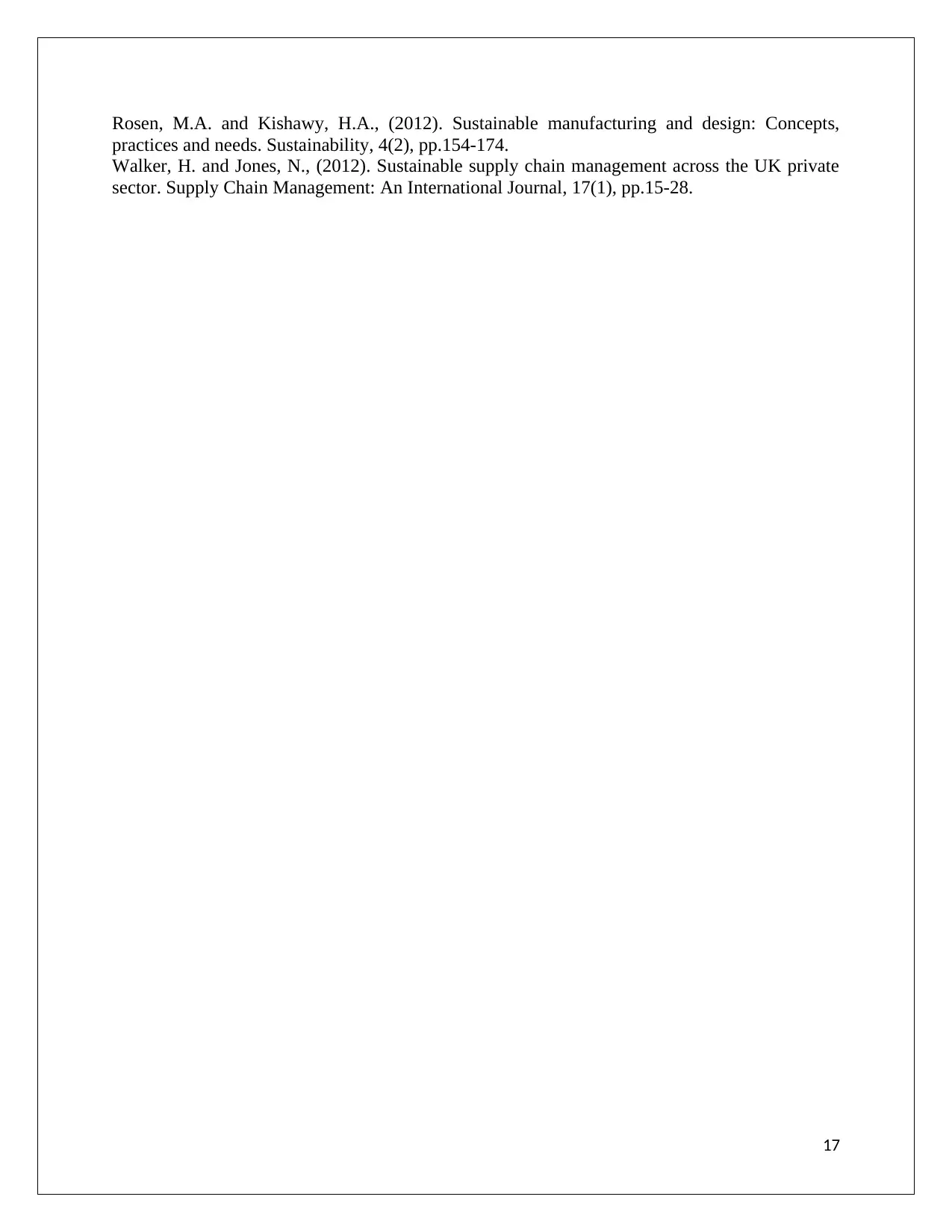
Rosen, M.A. and Kishawy, H.A., (2012). Sustainable manufacturing and design: Concepts,
practices and needs. Sustainability, 4(2), pp.154-174.
Walker, H. and Jones, N., (2012). Sustainable supply chain management across the UK private
sector. Supply Chain Management: An International Journal, 17(1), pp.15-28.
17
practices and needs. Sustainability, 4(2), pp.154-174.
Walker, H. and Jones, N., (2012). Sustainable supply chain management across the UK private
sector. Supply Chain Management: An International Journal, 17(1), pp.15-28.
17
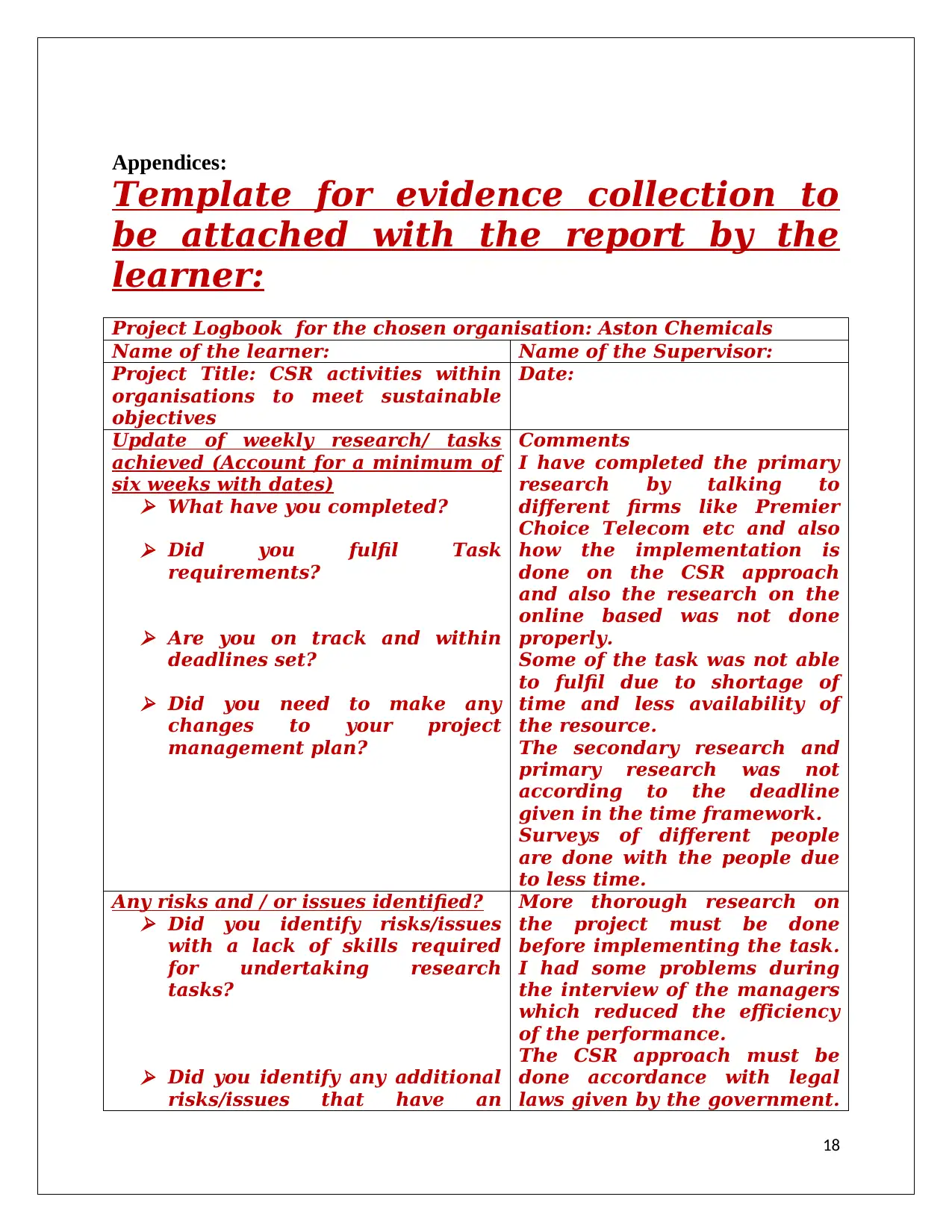
Appendices:
Template for evidence collection to
be attached with the report by the
learner:
Project Logbook for the chosen organisation: Aston Chemicals
Name of the learner: Name of the Supervisor:
Project Title: CSR activities within
organisations to meet sustainable
objectives
Date:
Update of weekly research/ tasks
achieved (Account for a minimum of
six weeks with dates)
What have you completed? Did you fulfil Task
requirements?
Are you on track and within
deadlines set? Did you need to make any
changes to your project
management plan?
Comments
I have completed the primary
research by talking to
different firms like Premier
Choice Telecom etc and also
how the implementation is
done on the CSR approach
and also the research on the
online based was not done
properly.
Some of the task was not able
to fulfil due to shortage of
time and less availability of
the resource.
The secondary research and
primary research was not
according to the deadline
given in the time framework.
Surveys of different people
are done with the people due
to less time.
Any risks and / or issues identified?
Did you identify risks/issues
with a lack of skills required
for undertaking research
tasks?
Did you identify any additional
risks/issues that have an
More thorough research on
the project must be done
before implementing the task.
I had some problems during
the interview of the managers
which reduced the efficiency
of the performance.
The CSR approach must be
done accordance with legal
laws given by the government.
18
Template for evidence collection to
be attached with the report by the
learner:
Project Logbook for the chosen organisation: Aston Chemicals
Name of the learner: Name of the Supervisor:
Project Title: CSR activities within
organisations to meet sustainable
objectives
Date:
Update of weekly research/ tasks
achieved (Account for a minimum of
six weeks with dates)
What have you completed? Did you fulfil Task
requirements?
Are you on track and within
deadlines set? Did you need to make any
changes to your project
management plan?
Comments
I have completed the primary
research by talking to
different firms like Premier
Choice Telecom etc and also
how the implementation is
done on the CSR approach
and also the research on the
online based was not done
properly.
Some of the task was not able
to fulfil due to shortage of
time and less availability of
the resource.
The secondary research and
primary research was not
according to the deadline
given in the time framework.
Surveys of different people
are done with the people due
to less time.
Any risks and / or issues identified?
Did you identify risks/issues
with a lack of skills required
for undertaking research
tasks?
Did you identify any additional
risks/issues that have an
More thorough research on
the project must be done
before implementing the task.
I had some problems during
the interview of the managers
which reduced the efficiency
of the performance.
The CSR approach must be
done accordance with legal
laws given by the government.
18
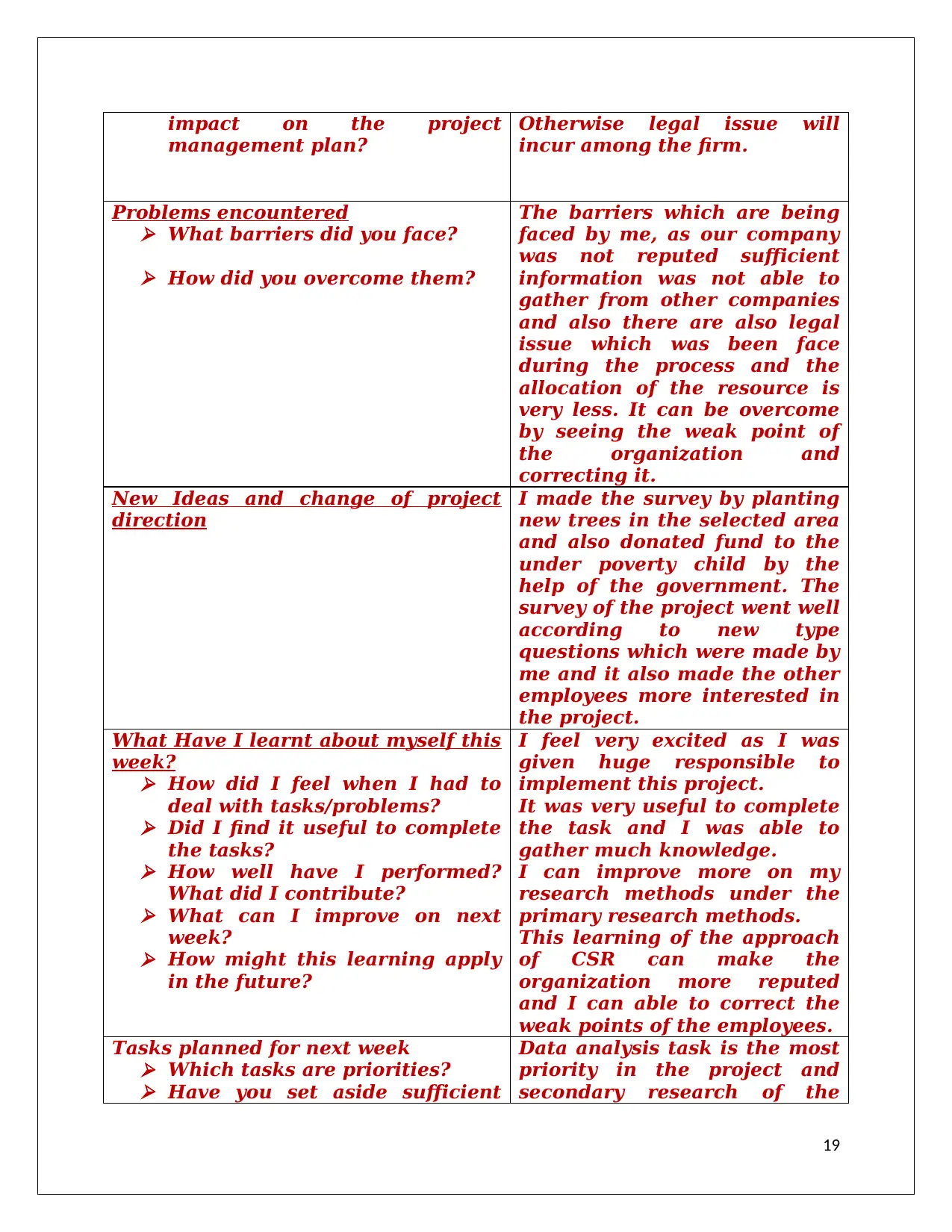
impact on the project
management plan?
Otherwise legal issue will
incur among the firm.
Problems encountered
What barriers did you face? How did you overcome them?
The barriers which are being
faced by me, as our company
was not reputed sufficient
information was not able to
gather from other companies
and also there are also legal
issue which was been face
during the process and the
allocation of the resource is
very less. It can be overcome
by seeing the weak point of
the organization and
correcting it.
New Ideas and change of project
direction
I made the survey by planting
new trees in the selected area
and also donated fund to the
under poverty child by the
help of the government. The
survey of the project went well
according to new type
questions which were made by
me and it also made the other
employees more interested in
the project.
What Have I learnt about myself this
week?
How did I feel when I had to
deal with tasks/problems?
Did I find it useful to complete
the tasks?
How well have I performed?
What did I contribute?
What can I improve on next
week?
How might this learning apply
in the future?
I feel very excited as I was
given huge responsible to
implement this project.
It was very useful to complete
the task and I was able to
gather much knowledge.
I can improve more on my
research methods under the
primary research methods.
This learning of the approach
of CSR can make the
organization more reputed
and I can able to correct the
weak points of the employees.
Tasks planned for next week
Which tasks are priorities?
Have you set aside sufficient
Data analysis task is the most
priority in the project and
secondary research of the
19
management plan?
Otherwise legal issue will
incur among the firm.
Problems encountered
What barriers did you face? How did you overcome them?
The barriers which are being
faced by me, as our company
was not reputed sufficient
information was not able to
gather from other companies
and also there are also legal
issue which was been face
during the process and the
allocation of the resource is
very less. It can be overcome
by seeing the weak point of
the organization and
correcting it.
New Ideas and change of project
direction
I made the survey by planting
new trees in the selected area
and also donated fund to the
under poverty child by the
help of the government. The
survey of the project went well
according to new type
questions which were made by
me and it also made the other
employees more interested in
the project.
What Have I learnt about myself this
week?
How did I feel when I had to
deal with tasks/problems?
Did I find it useful to complete
the tasks?
How well have I performed?
What did I contribute?
What can I improve on next
week?
How might this learning apply
in the future?
I feel very excited as I was
given huge responsible to
implement this project.
It was very useful to complete
the task and I was able to
gather much knowledge.
I can improve more on my
research methods under the
primary research methods.
This learning of the approach
of CSR can make the
organization more reputed
and I can able to correct the
weak points of the employees.
Tasks planned for next week
Which tasks are priorities?
Have you set aside sufficient
Data analysis task is the most
priority in the project and
secondary research of the
19
Secure Best Marks with AI Grader
Need help grading? Try our AI Grader for instant feedback on your assignments.
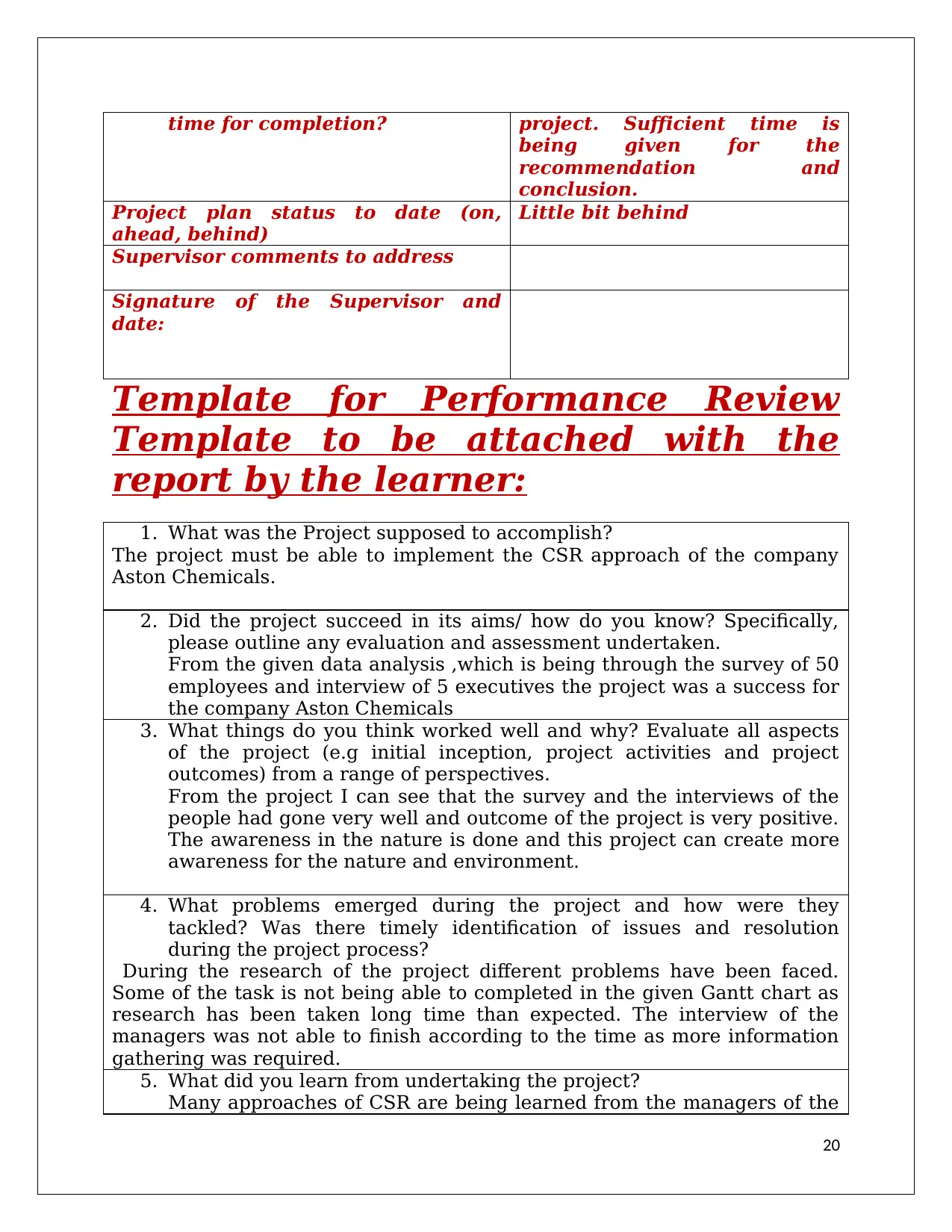
time for completion? project. Sufficient time is
being given for the
recommendation and
conclusion.
Project plan status to date (on,
ahead, behind)
Little bit behind
Supervisor comments to address
Signature of the Supervisor and
date:
Template for Performance Review
Template to be attached with the
report by the learner:
1. What was the Project supposed to accomplish?
The project must be able to implement the CSR approach of the company
Aston Chemicals.
2. Did the project succeed in its aims/ how do you know? Specifically,
please outline any evaluation and assessment undertaken.
From the given data analysis ,which is being through the survey of 50
employees and interview of 5 executives the project was a success for
the company Aston Chemicals
3. What things do you think worked well and why? Evaluate all aspects
of the project (e.g initial inception, project activities and project
outcomes) from a range of perspectives.
From the project I can see that the survey and the interviews of the
people had gone very well and outcome of the project is very positive.
The awareness in the nature is done and this project can create more
awareness for the nature and environment.
4. What problems emerged during the project and how were they
tackled? Was there timely identification of issues and resolution
during the project process?
During the research of the project different problems have been faced.
Some of the task is not being able to completed in the given Gantt chart as
research has been taken long time than expected. The interview of the
managers was not able to finish according to the time as more information
gathering was required.
5. What did you learn from undertaking the project?
Many approaches of CSR are being learned from the managers of the
20
being given for the
recommendation and
conclusion.
Project plan status to date (on,
ahead, behind)
Little bit behind
Supervisor comments to address
Signature of the Supervisor and
date:
Template for Performance Review
Template to be attached with the
report by the learner:
1. What was the Project supposed to accomplish?
The project must be able to implement the CSR approach of the company
Aston Chemicals.
2. Did the project succeed in its aims/ how do you know? Specifically,
please outline any evaluation and assessment undertaken.
From the given data analysis ,which is being through the survey of 50
employees and interview of 5 executives the project was a success for
the company Aston Chemicals
3. What things do you think worked well and why? Evaluate all aspects
of the project (e.g initial inception, project activities and project
outcomes) from a range of perspectives.
From the project I can see that the survey and the interviews of the
people had gone very well and outcome of the project is very positive.
The awareness in the nature is done and this project can create more
awareness for the nature and environment.
4. What problems emerged during the project and how were they
tackled? Was there timely identification of issues and resolution
during the project process?
During the research of the project different problems have been faced.
Some of the task is not being able to completed in the given Gantt chart as
research has been taken long time than expected. The interview of the
managers was not able to finish according to the time as more information
gathering was required.
5. What did you learn from undertaking the project?
Many approaches of CSR are being learned from the managers of the
20
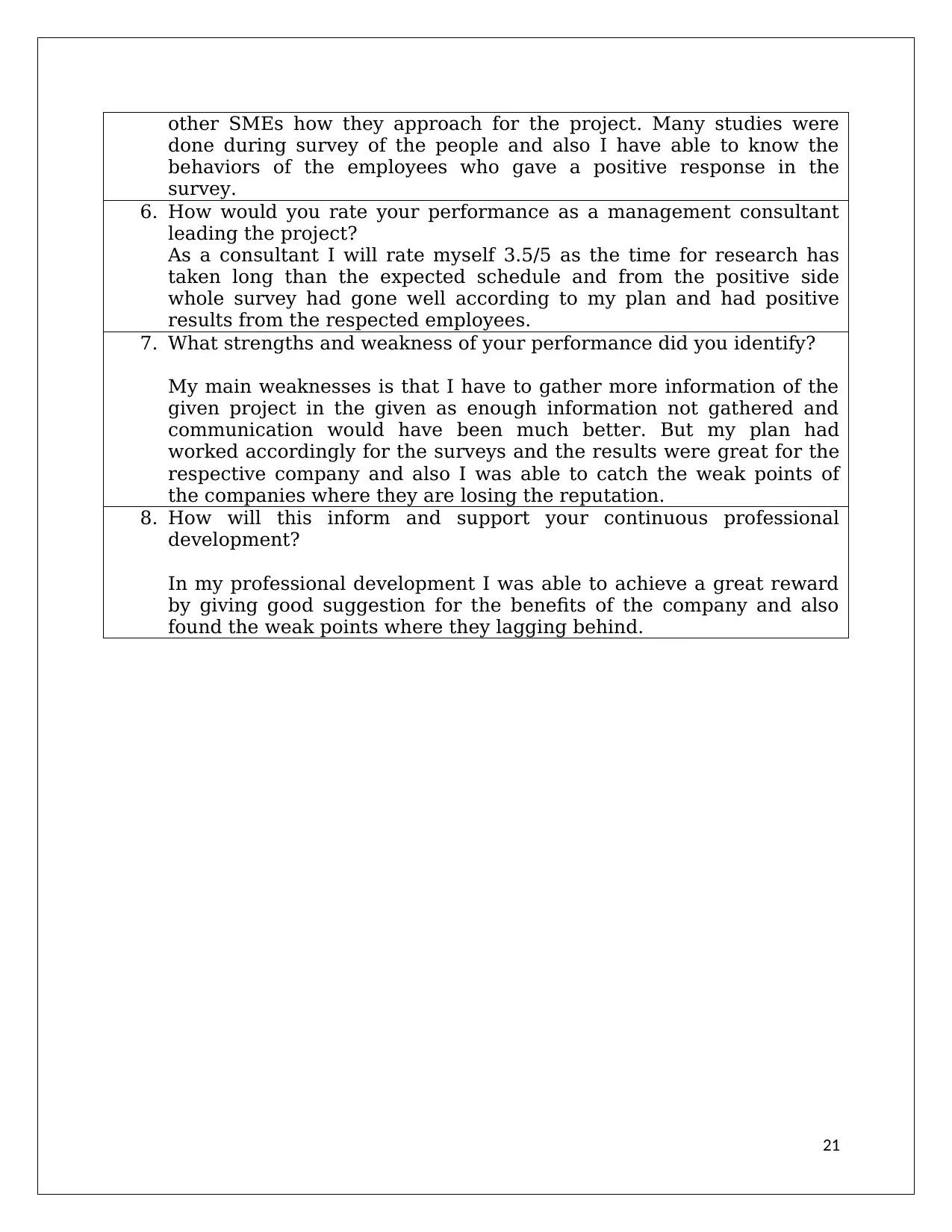
other SMEs how they approach for the project. Many studies were
done during survey of the people and also I have able to know the
behaviors of the employees who gave a positive response in the
survey.
6. How would you rate your performance as a management consultant
leading the project?
As a consultant I will rate myself 3.5/5 as the time for research has
taken long than the expected schedule and from the positive side
whole survey had gone well according to my plan and had positive
results from the respected employees.
7. What strengths and weakness of your performance did you identify?
My main weaknesses is that I have to gather more information of the
given project in the given as enough information not gathered and
communication would have been much better. But my plan had
worked accordingly for the surveys and the results were great for the
respective company and also I was able to catch the weak points of
the companies where they are losing the reputation.
8. How will this inform and support your continuous professional
development?
In my professional development I was able to achieve a great reward
by giving good suggestion for the benefits of the company and also
found the weak points where they lagging behind.
21
done during survey of the people and also I have able to know the
behaviors of the employees who gave a positive response in the
survey.
6. How would you rate your performance as a management consultant
leading the project?
As a consultant I will rate myself 3.5/5 as the time for research has
taken long than the expected schedule and from the positive side
whole survey had gone well according to my plan and had positive
results from the respected employees.
7. What strengths and weakness of your performance did you identify?
My main weaknesses is that I have to gather more information of the
given project in the given as enough information not gathered and
communication would have been much better. But my plan had
worked accordingly for the surveys and the results were great for the
respective company and also I was able to catch the weak points of
the companies where they are losing the reputation.
8. How will this inform and support your continuous professional
development?
In my professional development I was able to achieve a great reward
by giving good suggestion for the benefits of the company and also
found the weak points where they lagging behind.
21
1 out of 21
Related Documents
Your All-in-One AI-Powered Toolkit for Academic Success.
+13062052269
info@desklib.com
Available 24*7 on WhatsApp / Email
![[object Object]](/_next/static/media/star-bottom.7253800d.svg)
Unlock your academic potential
© 2024 | Zucol Services PVT LTD | All rights reserved.





